GemTek Technology R950829G High Performance Hotspot Access Point User Manual BW1330 UG v1 0
Gemtek Technology Co., Ltd. High Performance Hotspot Access Point BW1330 UG v1 0
Contents
- 1. Manual Part 1
- 2. Manual Part 2
- 3. Manual Part 3
Manual Part 3
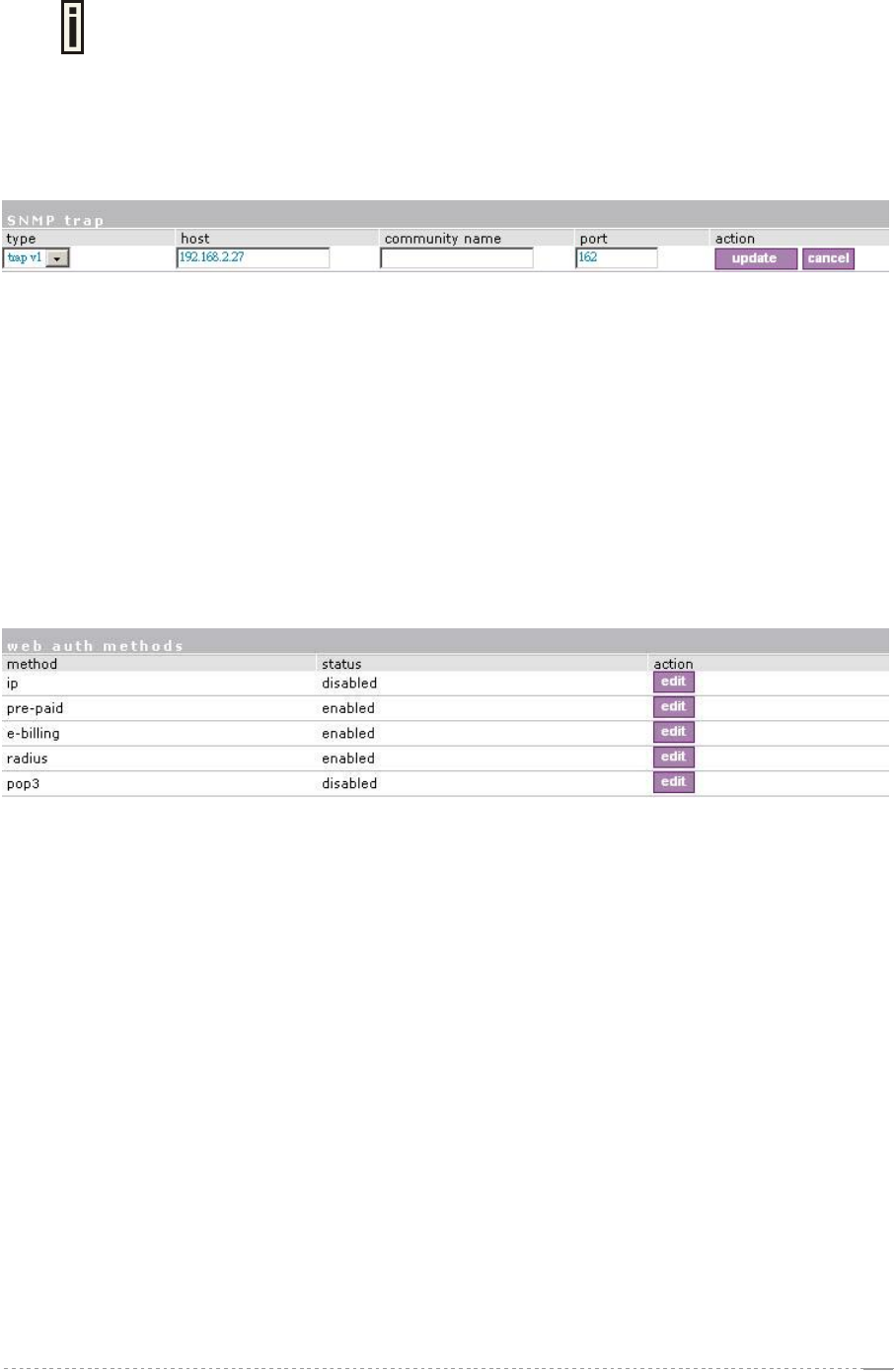
User’s Guide Version 1.0
If no OID is specified all SNMP request to the controller will be redirected to a
specific host.
SNMP Trap Table:
You can configure your SNMP agent to send SNMP Traps (and/or inform notifications) under the
defined host (SNMP manager) and community name (optional).
Figure 192 – SNMP Trap Table
Type – select trap message type [v1/v2/inform].
Host – enter SNMP manager IP address [dots and digits].
Community Name – specify the community name at a SNMP trap message. This community will be
used in trap messages to authenticate the SNMP manager. If not defined, the default trap community
name will be used (specified in the SNMP table) [1-32 all ASCII printable characters, no spaces].
Port – enter the port number the trap messages should be send through [number].
System | Access | Web Auth
Web auth controls all the built-in AAA web authentication method.
Figure 193 – Web Authentication methods
IP: IP authentication method. it means every client who has an IP address can be authenticated.
Before client authentication, its first web access of client will be redirected to a confirm/login page,
Need not any username or password, user just press confirm or OK button then client will be
automatically authenticated and client‘s MAC address will be act as the username of login session.
Pre-paid: If Pre-paid authentication was disabled, BW1330 would not use pre-paid database to
authenticate clients.
e-billing: If e-billing authentication was disabled, BW1330 would not use E-Billing built-in database to
authenticate clients.
RADIUS: BW1330 would use extern RADIUS server to do authenticate client if RADIUS
authentication setting was enabled.
POP3: By using pop3 mail address for user authentication.
BW1330 executes the web authentication with the below web authentication method order: IP auth,
Pre-paid auth, e-billing Auth and RADIUS auth. If one auth method failed (including setting of the
auth method is disabled), try next.
BROWAN Page
109
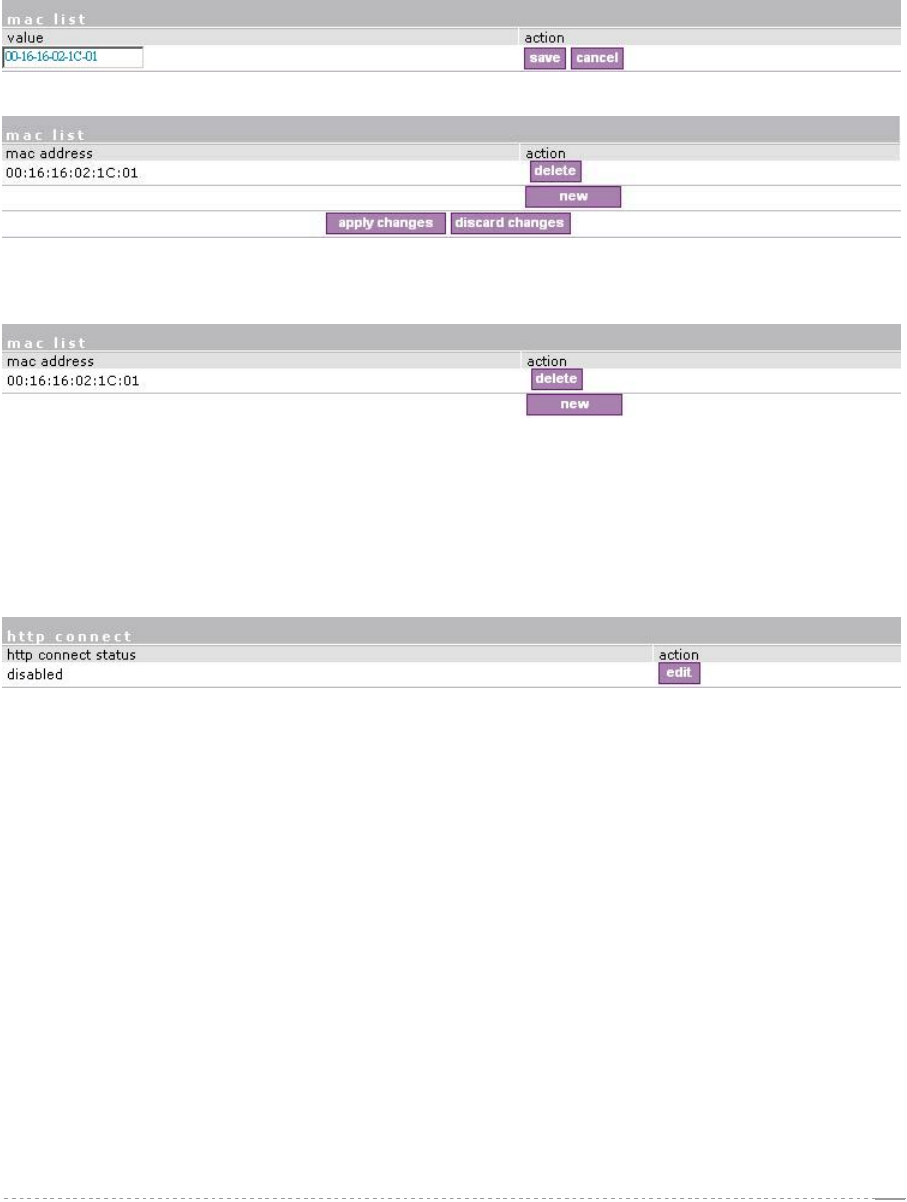
User’s Guide Version 1.0
System | Access | Mac List
The MAC list is a client pass-through table. If MACACL (system | Access | AAA) is enabled and the
client’s MAC address is belong to this table. Then the client will be authorized transparently. (Please
refer to MACACL item in System | Access | AAA.
Press the “NEW” button to add a new MAC address to the table. The format of a MAC address can be:
xx:xx:xx:xx:xx:xx or xx-xx-xx-xx-xx-xx or xxxxxxxxxx
figure 194-MAC format
Figure 195 – MAC List for MAC-ACL
Press the “apply changes” button to save the changes to flash after you finish your input..
Figure 196 – Add new MAC address
System | Access | HTTPC
For web authentication, this item configure whether redirect web logon user to a HTTPS logon page
or HTTP page.
Figure 197 – HTTPC configuration for web logon.
Default configuration is disabled. It means web logon client will be redirected to a HTTPS logon page
for more security.
System | Status
Use the system | status menu to check the BW1330 current status:
Device statistics (including device name, model, firmware version, status, logged administrators,
general uptime, memory, load, connected clients)
BROWAN Page
110
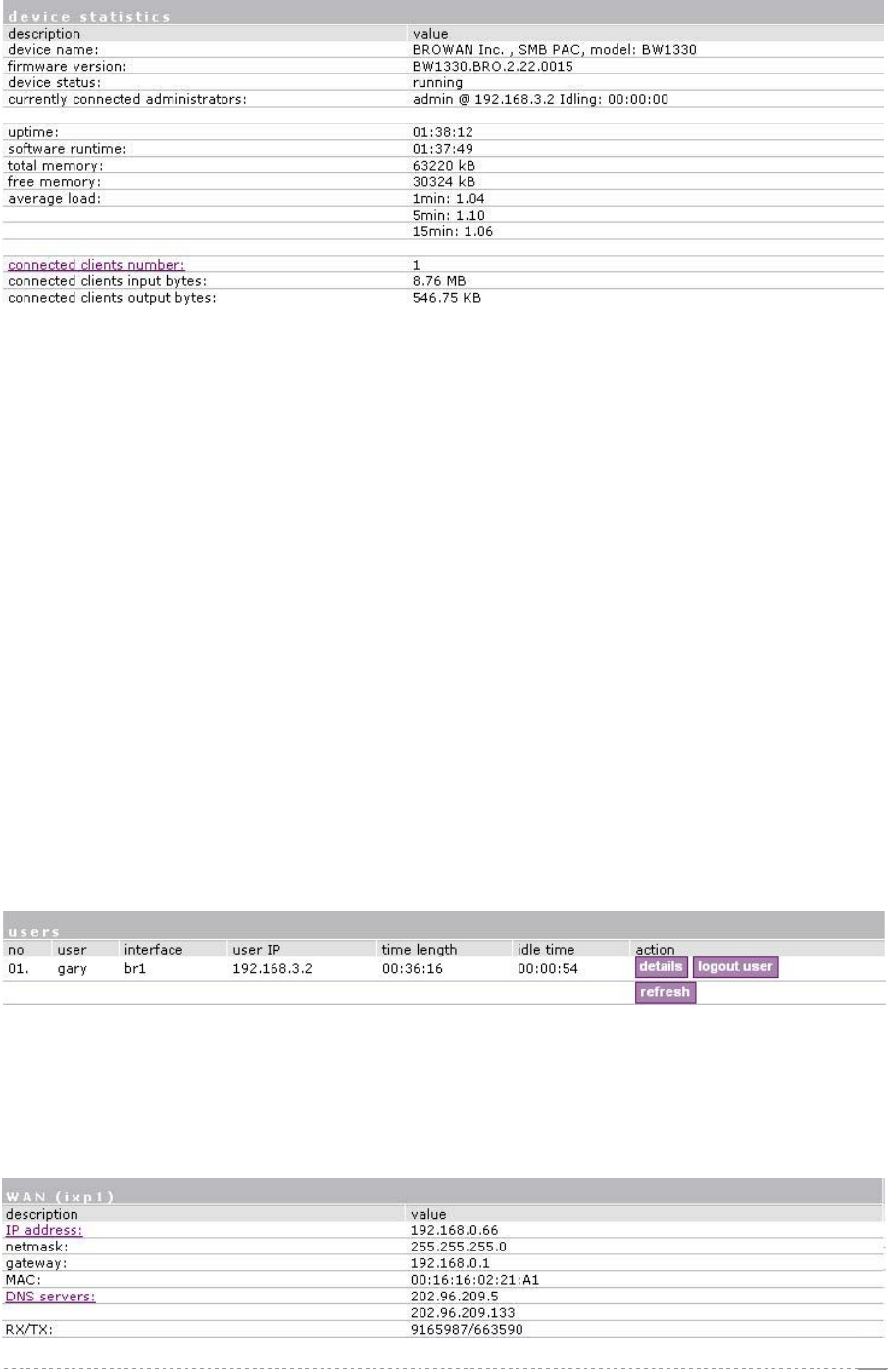
User’s Guide Version 1.0
Figure 198 – Device Statistics
Device Name – full device name and model.
Firmware Version – the current version of the firmware.
Device Status – current device status: running/warning.
Currently Connected Administrators – logged administrators list in format: [administrator name, IP
address, and idling time in hours/minutes/seconds].
Uptime – indicates the time, expressed in days, hours and minutes since the system was last
rebooted [days/hours/minutes/seconds].
Software Runtime – indicates the time, expressed in days, hours and minutes since the software
reboot. The system itself can restart the software without rebooting the device
[days/hours/minutes/seconds].
Total Memory – total operational memory of your BW1330 [kB].
Free Memory – indicates the memory currently available in the controller [kB].
Average Load – indicates the average load of the BW1330 processor in the period of the last
1minute, 5 minutes and 15 minutes (a larger value means a larger average load on the processor).
Minimum load – 1.0
Normal load – should not exceed 2.0 (including)
Processor is busy – more than 2.0
Connected Clients Number – total number of current connected clients. Click on the settings and get
detailed connected clients list (clients page under the connection | user):
Figure 199 – Connected Clients Detailed List
Connected Clients Input Bytes – current connected clients’ total Input bytes [K, KB, MB, GB].
Connected Clients Output Bytes – current connected clients’ total Output bytes [K, KB, MB, GB].
WAN interface (ixp1) (including the IP address, netmask, gateway, MAC address of the WAN
interface, DNS servers, RX/TX statistics)
BROWAN Page
111
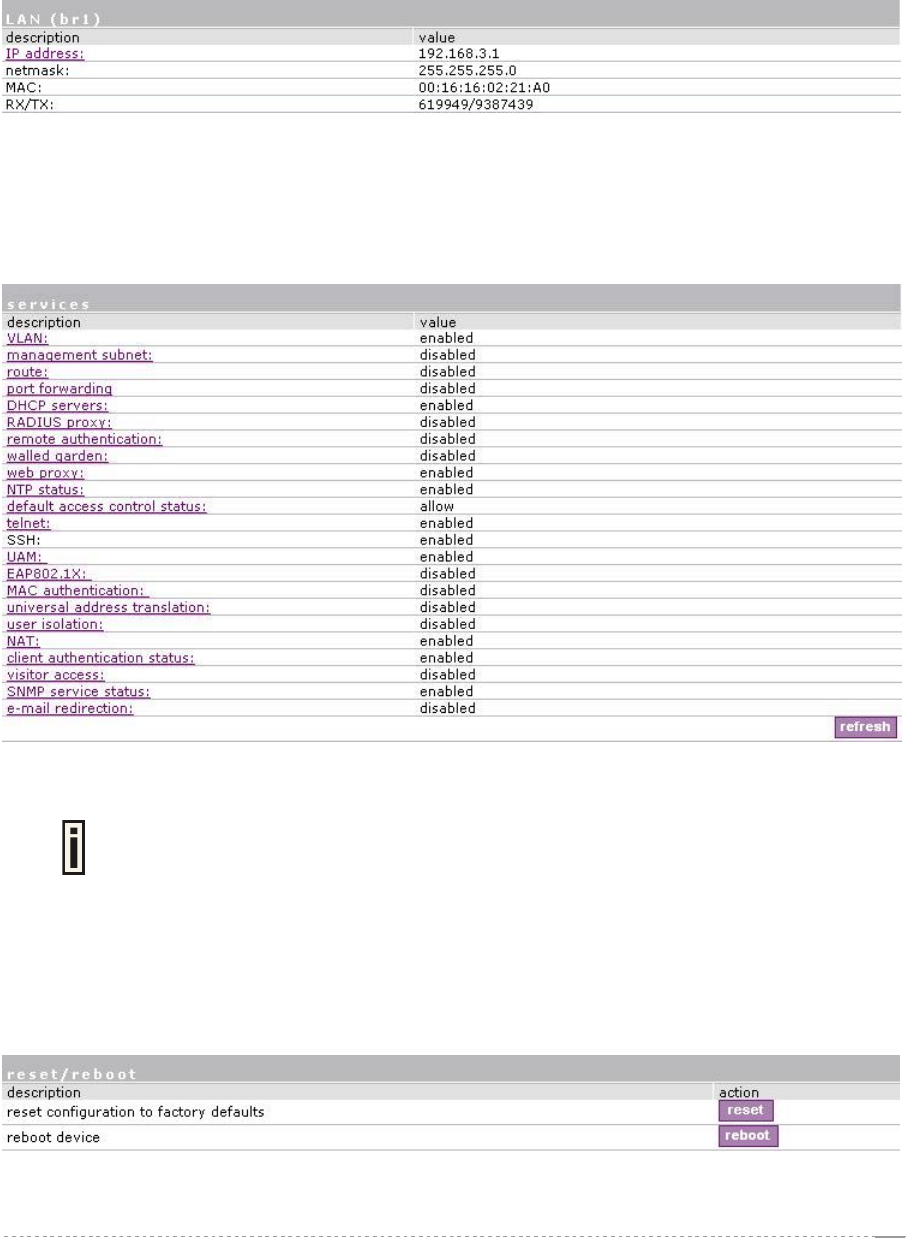
User’s Guide Version 1.0
Figure 200 – WAN Interface Statistics
RX – indicates data volume received on the WAN interface since reboot.
TX – indicates data volume transmitted to the WAN interface since reboot.
LAN interface (br1) (including the IP address, netmask, MAC address of the LAN interface,
RX/TX statistics)
Figure 201 – LAN Interface Statistics
RX – indicates data volume received on the LAN interface since reboot.
TX – indicates data volume transmitted to the LAN interface since reboot.
Services (all services list with its status: enabled/disabled)
Figure 202 – Services
Services are displayed as a link to the respective menu where status can be
configured.
Refresh – click the button to refresh device status statistics.
System | Reset
If you need to reboot your device or reset to factory defaults select the system | reset menu:
Figure 203 – Reset and Reboot
Reset – reset device to factory default values.
BROWAN Page
112
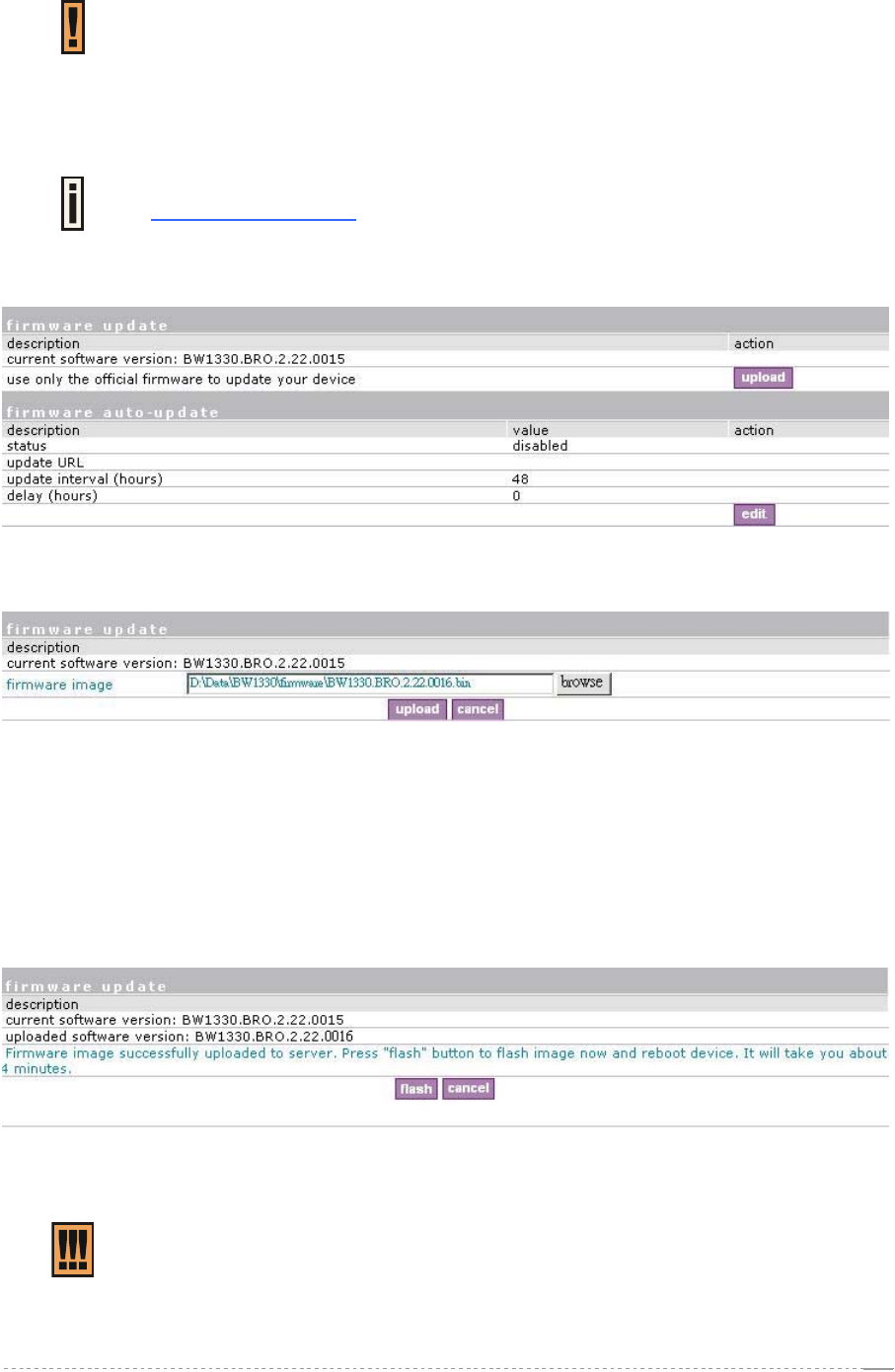
User’s Guide Version 1.0
Keep in mind that resetting the device is an irreversible process.
Please note that even the administrator password will be set back to the factory
default.
Reboot – reboot device with the last saved configuration.
System | Update
Check for new product updates at the Browan Communications website:
http://www.browan.com
To update your device firmware, use only the original firmware image and under system | update
menu click the upload button:
Figure 204 – Firmware Update
Specify the full path to the new firmware image and click the upload button:
Figure 205 – New Firmware Upload
Firmware Image – enter the firmware image using the full path.
Browse – click the button to specify the new image location.
Upload – upload with new firmware.
Cancel – cancel the upload process.
New firmware image is uploaded into the controller. Now you need to upload this new firmware into
the controller’s FLASH memory, click the flash button:
Figure 206 – Flash New Image
Flash – flash new image, reboots the system.
Do not switch off and do not disconnect the BW1330 from the power supply during
the firmware update process because the device could be damaged.
BROWAN Page
113
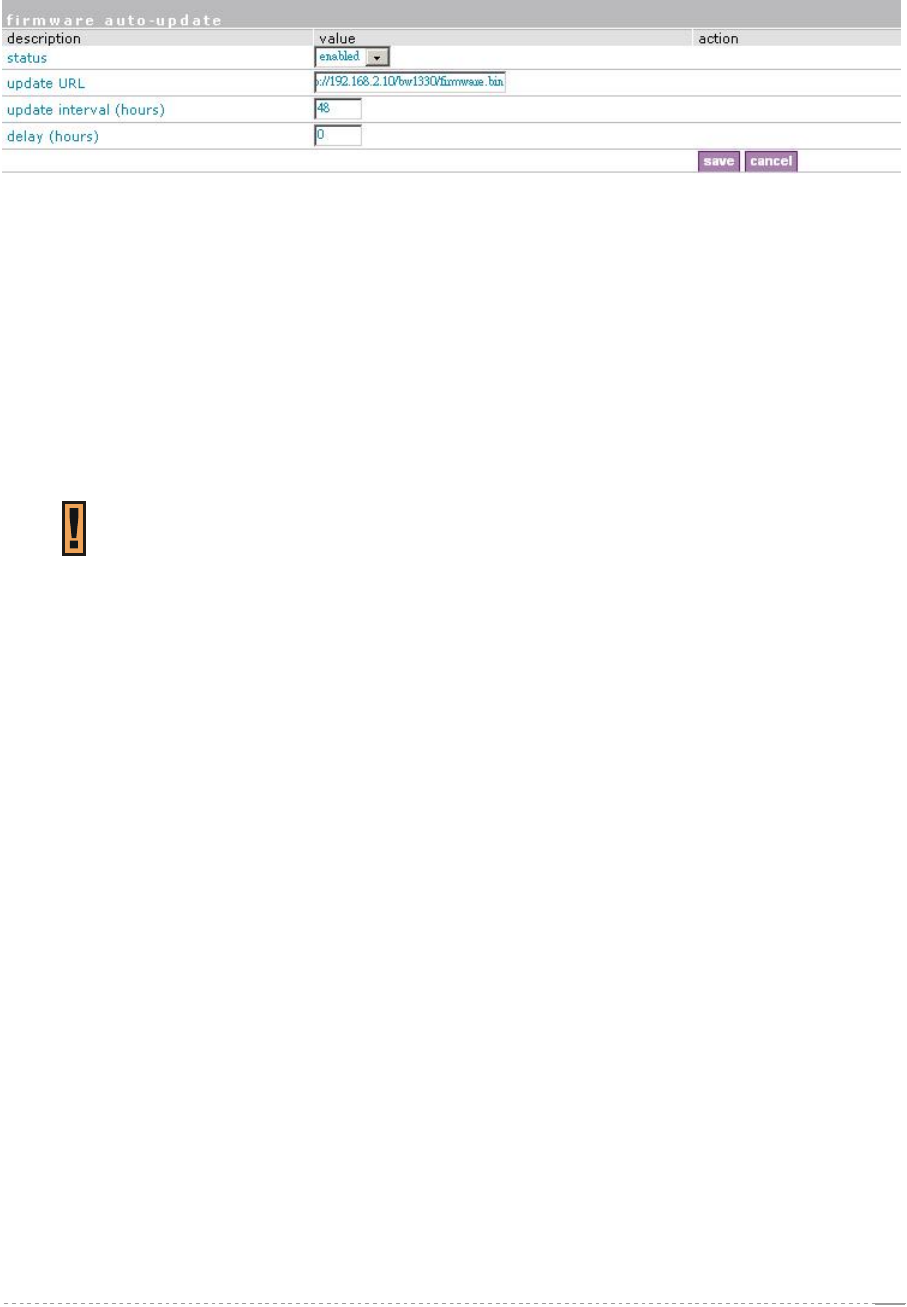
User’s Guide Version 1.0
Firmware auto-update:
Auto-update function allows update device firmware automatically. This function will help for large
enterprises, having hundreds of AC's, to keep them up to date.
Figure 207 – Firmware Auto-update Configuration
Status - defines if auto-update is enabled or disabled. Default value disabled.
Update URL - defines where firmware should be downloaded from. It points directly to firmware
update file. URL should be accessible without any user authentication. URL can use HTTP, HTTPS
and FTP protocols. Default value - empty string.
Update interval – define the time interval between each update in hours [1-9999]. Time is counted
from last device boot-on. Default value is 48 hours.
Delay – delays update process by given amount of hours. This should prevent from getting hundreds
requests for firmware download at the same time [0-24]. Default value is 0.
Save - save new firmware auto-update settings.
On boot auto-update feature checks for available updates on specified server at
given URL. If there is different version - device downloads, installs firmware update
and reboots. If firmware version matches current version on device - no update
takes place.
BROWAN Page
114
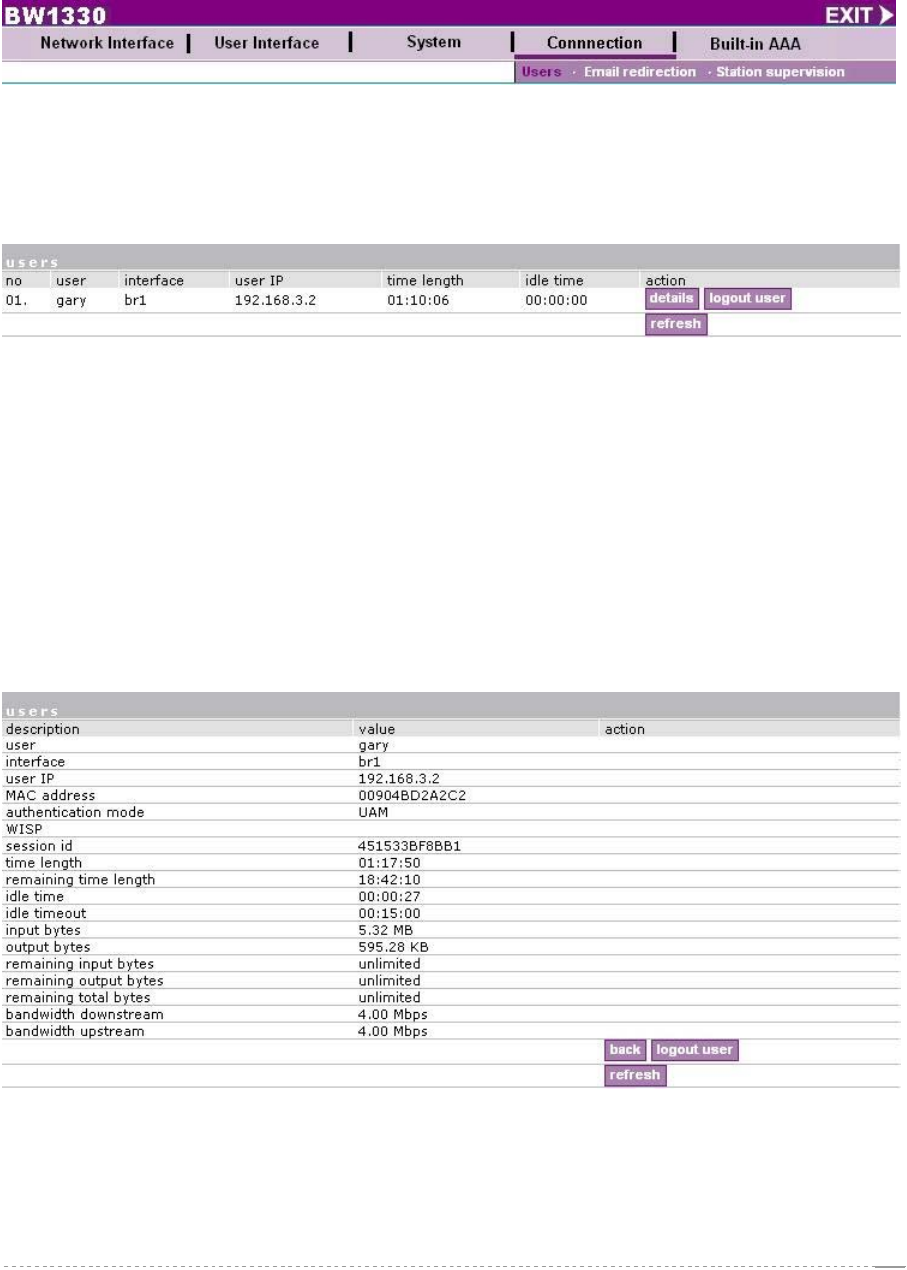
User’s Guide Version 1.0
Connection
Use the connection menu to view the connected user’s statistics, set outgoing mail server or observe
the connected station availability.
Figure 208 – Connection Menu
Connection | Users
The users menu is for viewing the connected users’ statistics. Also ability to logout user from the
system is implemented here:
Figure 209– Users’ Statistics
The users’ statistics parameters are as follows:
No – number of the user’s session connection.
User – username of the connected client.
Interface – name of interface, through which client is connected [br1].
User IP – IP address, from which the user’s connection is established. Address is presented in digits
and dots notation.
Time length - session duration since the user login.
Idle Time - amount of user inactivity time [hours: minutes: seconds].
Details – click on user details to get more information about the client:
Figure 210 – User’s Details
User – the username of the connected client.
Interface – name of interface, through which client is connected.
User IP – IP address, from which the user’s connection is established. Address is presented in digits
and dots notation.
BROWAN Page
115

User’s Guide Version 1.0
MAC Address – hardware address of the network device from which the user is connected.
Authentication mode – authentication method which user uses to connect.
WISP – WISP domain name where the user belongs.
Session ID – the unique user’s session ID number. This can be used for troubleshooting purposes.
Time length – session time duration since user login [hours: minutes: seconds/unlimited].
Remaining Time length– remaining user’s session time [hours: minutes: seconds/unlimited]. Session
time for user is defined in the RADIUS server.
Idle Time - amount of user inactivity time [hours: minutes: seconds].
Input Bytes - amount of data in bytes, which the user network device has received [Bytes].
Output Bytes - amount of data in bytes, transmitted by the user network device [Bytes].
Remaining input/output/total bytes – user session remaining input/output bytes. WISP Operator
can define the user session in bytes. Remaining bytes is received from RADIUS [Bytes/unlimited].
Bandwidth downstream/upstream – user upstream and downstream bandwidth [in bps].
Back – returns to connected client’s statistics list.
Logout User – click this button to explicitly logout user from the network.
Refresh – click the button to refresh users’ statistics.
BROWAN Page
116
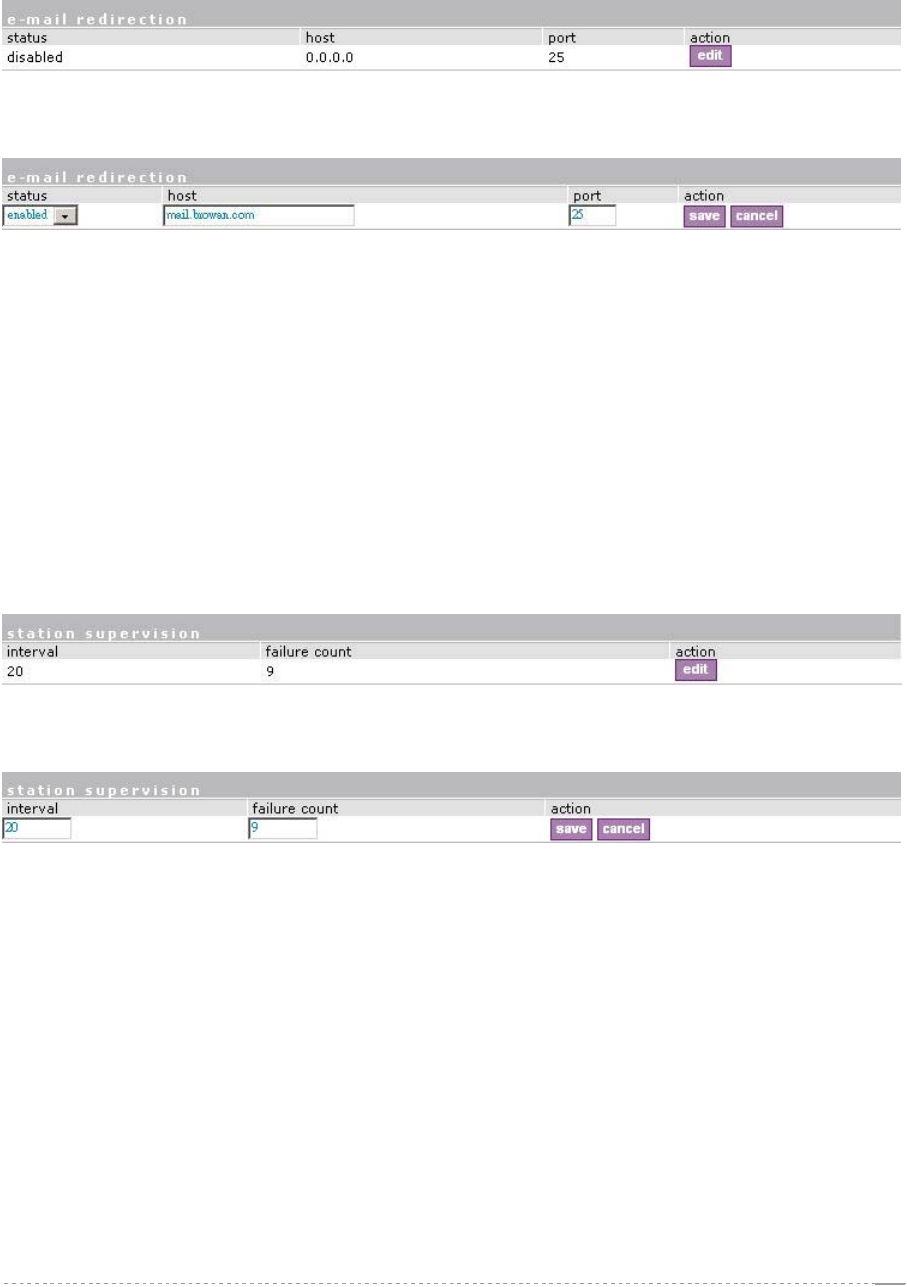
User’s Guide Version 1.0
Connection | E-mail Redirection
The outgoing mail (SMTP) server redirection is performed using the e-mail redirection menu. By
default such redirection settings is displayed:
Figure 211 – E-mail Redirection Settings
Click the edit button to specify your outgoing mail server settings.
Figure 212 – Edit E-mail Redirection
Status – enable/disable e-mail redirection function.
Host – SMTP server address where to redirect the outgoing clients e-mails [enter host name or host
IP address].
Port – port number [number, by default: 25].
Save – save new e-mail redirection settings.
Connection | Station Supervision
The station supervision function is used to monitor the connected host station availability. This
monitoring is performed with ping. If the specified number of ping failures is reached (failure count),
the user is logged out from the AC.
Figure 213 – Station Supervision
To adjust the ping interval/failure count, click the Edit button.
Figure 214 – Edit Station Supervision
Interval – define interval of sending ping to host [in seconds].
Failure Count – failure count value after which the user is logged out from the system.
Save – save station supervision settings.
Cancel – cancel changes.
BROWAN Page
117
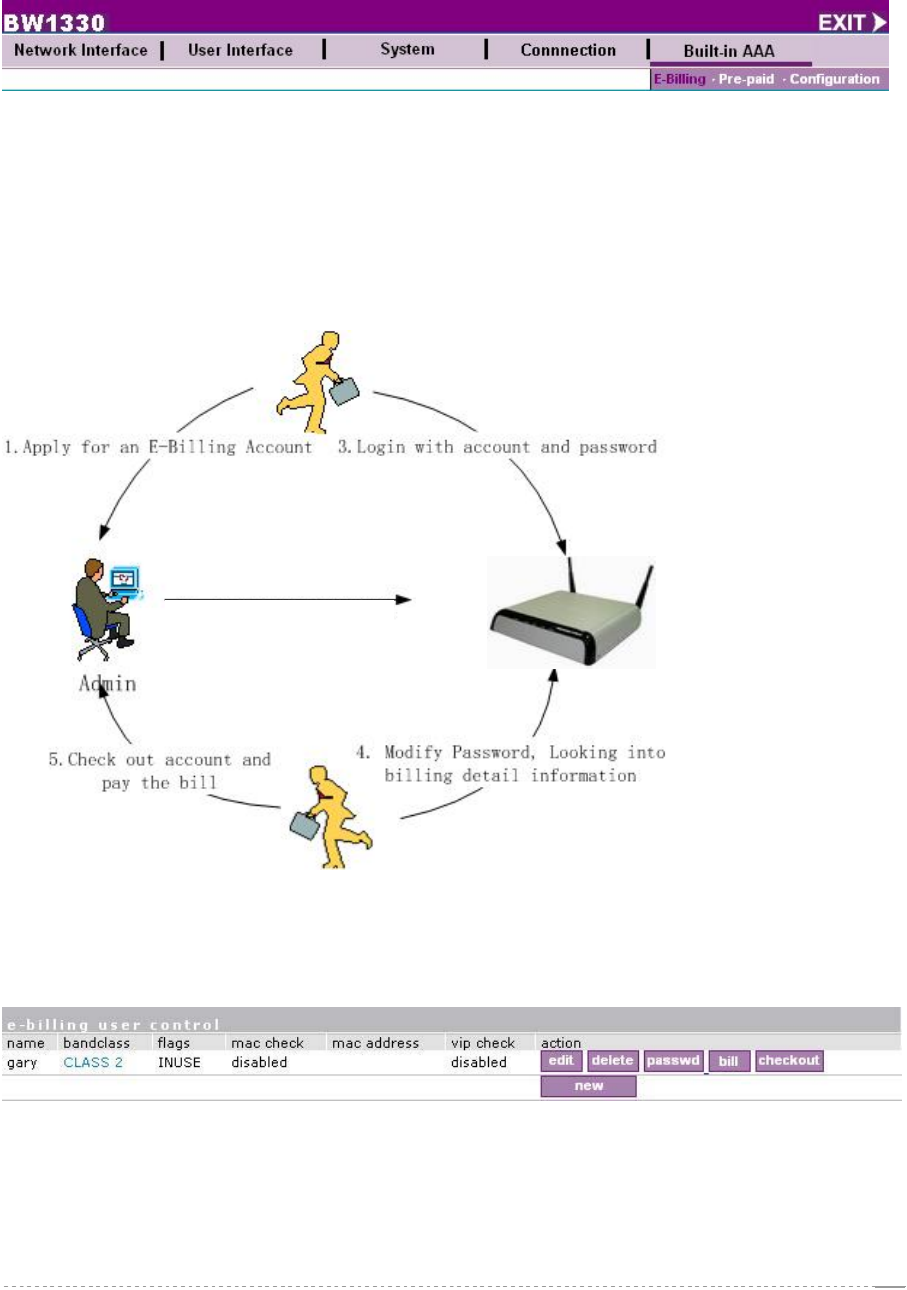
User’s Guide Version 1.0
Built-In AAA
Use built-in AAA to configure the post-paid account (e-billing) and pre-paid account (pre-paid) of built-
in AAA system.
Figure 215 – Built-In AAA Menu
Built-in AAA | E-Billing
Hotspot owner can use this function to create E-Billing user account, set the E-Billing account billing
policy and price. With this feature, hotspot owner can setup public access service without external
RADIUS server.
2.create an E-Billing
account on BW1330
Figure 216 – E-Billing operate mode
Built-in AAA | E-Billing | User Control
“User control” provides an interface to manage E-Billing user accounts.
Figure 217 – Ebilling accounts
You can edit or delete exist E-Billing accounts, change their password or check account’s billing
information. Click the “new” button will create a new E-Billing account.
BROWAN Page
118
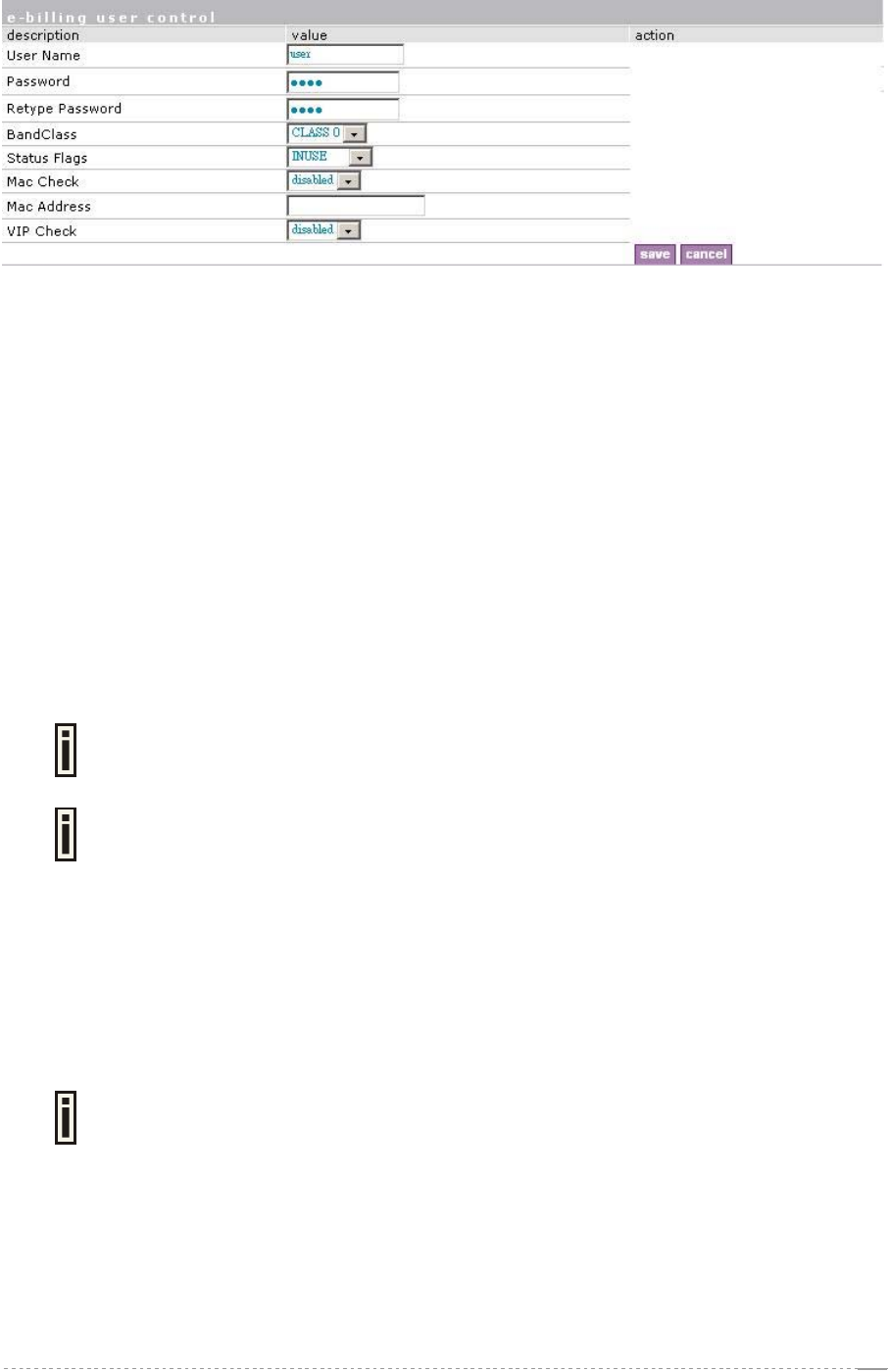
User’s Guide Version 1.0
Figure 218 – Create new ebilling account
New created account need fill out below item:
1. User Name – user of e-billing account.
2. password – Password of the user to be logged on.
3. retype password – re-enter the new password to verify its accuracy
4. Band Class: means account priority, BW1330 support 3 priority class for E-Billing account, each
priority class relevant to different bandwidth. Detail will descript in Built-in AAA| E-Billing| Band
Class
5. Status flags: InUse, Suspend and NoUse.
InUse: This account is normal, user can use this account to login.
Suspend: This account will be temporary suspend for some reason such as this account will not
be use for some days.
NoUse: This account will be NoUse. Account recycle will delete this account after 72 hours.
If E-Billing account status flags are NoUse or Suspend, this logon process by this
account will be failed.
The different of NoUse and Suspend is for administrator’s facility to distinguish E-
Billing accounts status.
Suggestion: If an account is check-out, it is better to change the account status to
NoUse and keep for some days rather than delete this account to for user re-check
the account detail.
6. Mac check and Mac address: If “Mac Check” is enabled, This account will bind a special MAC
address for more security. Other clients with different MAC address will not be login success even
use the right account and password.
7. VIP Check: if this account is a VIP account, the VIP Check status must be enabled. The billing
policy of the account will be daily policy.
It is suggested that the VIP account class is higher than the normal account for
example class 1 for 2M bps bandwidth.
If an account was changed from Normal to VIP or VIP to Normal, BW1330 will
count charge of this account as totally VIP/Normal account when he check-out.
Once a new account has been created, an account receipt will be output from the account printer
(A720 and printer converter A-721)) which connected to BW1330.
BROWAN Page
119
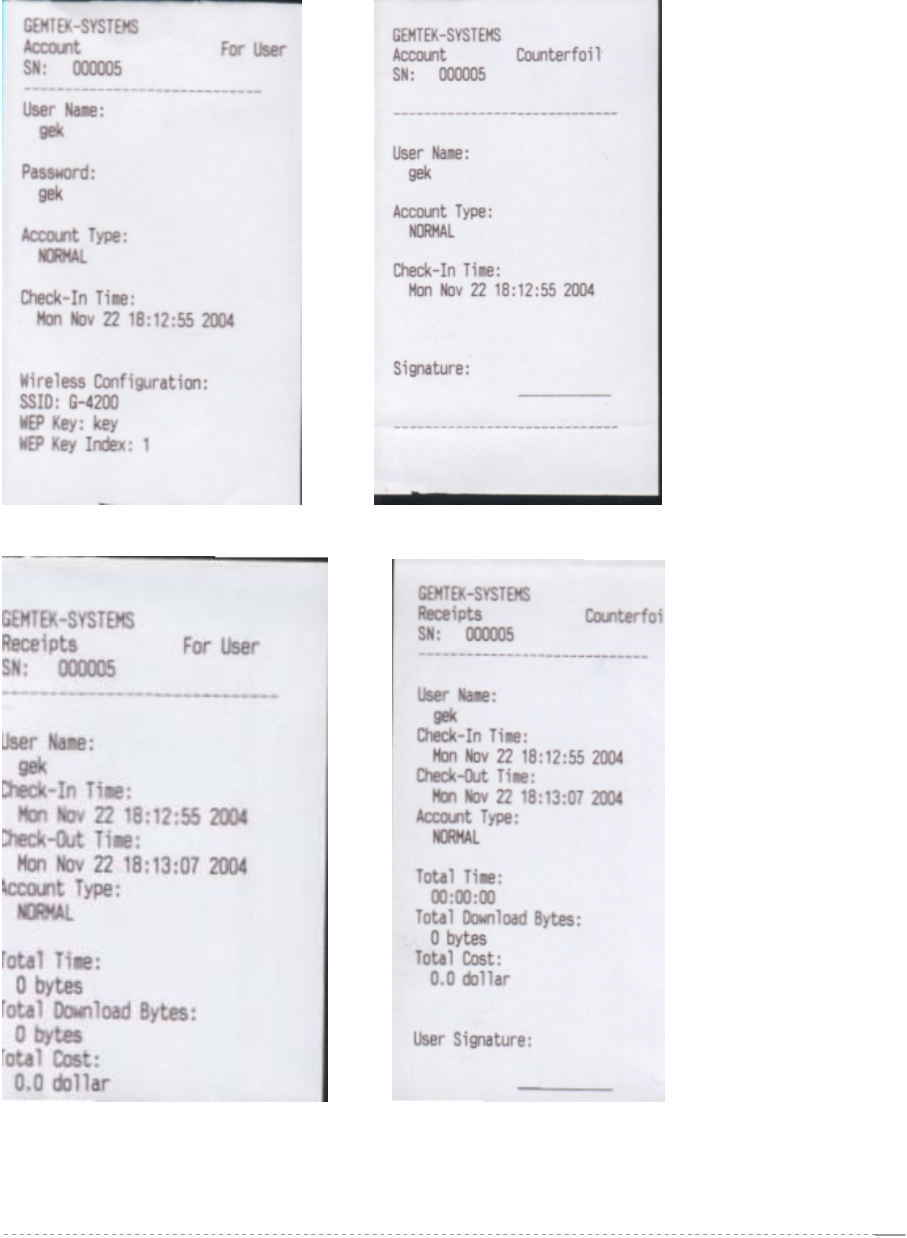
User’s Guide Version 1.0
If a E-Billing account needs to be checked out, just click the “checkout” button, and the detail billing
receipt of this account which record the total cost and total using time will be output from the account
printer and the status of this account will be set to NOUSE. After 72 hours, this account will be
automatically removed.
Below is the printed receipt of account (for user and for counterfoil) when user check-in and user bill
receipts (for user and for counterfoil) when user checkout.
Figure 219 – Account receipt (for user) Figure 220 – Account receipt (counterfoil)
Figure 221 – Bill Receipt (for user) Figure 222 – Bill receipt (Counterfoil)
BROWAN Page
120
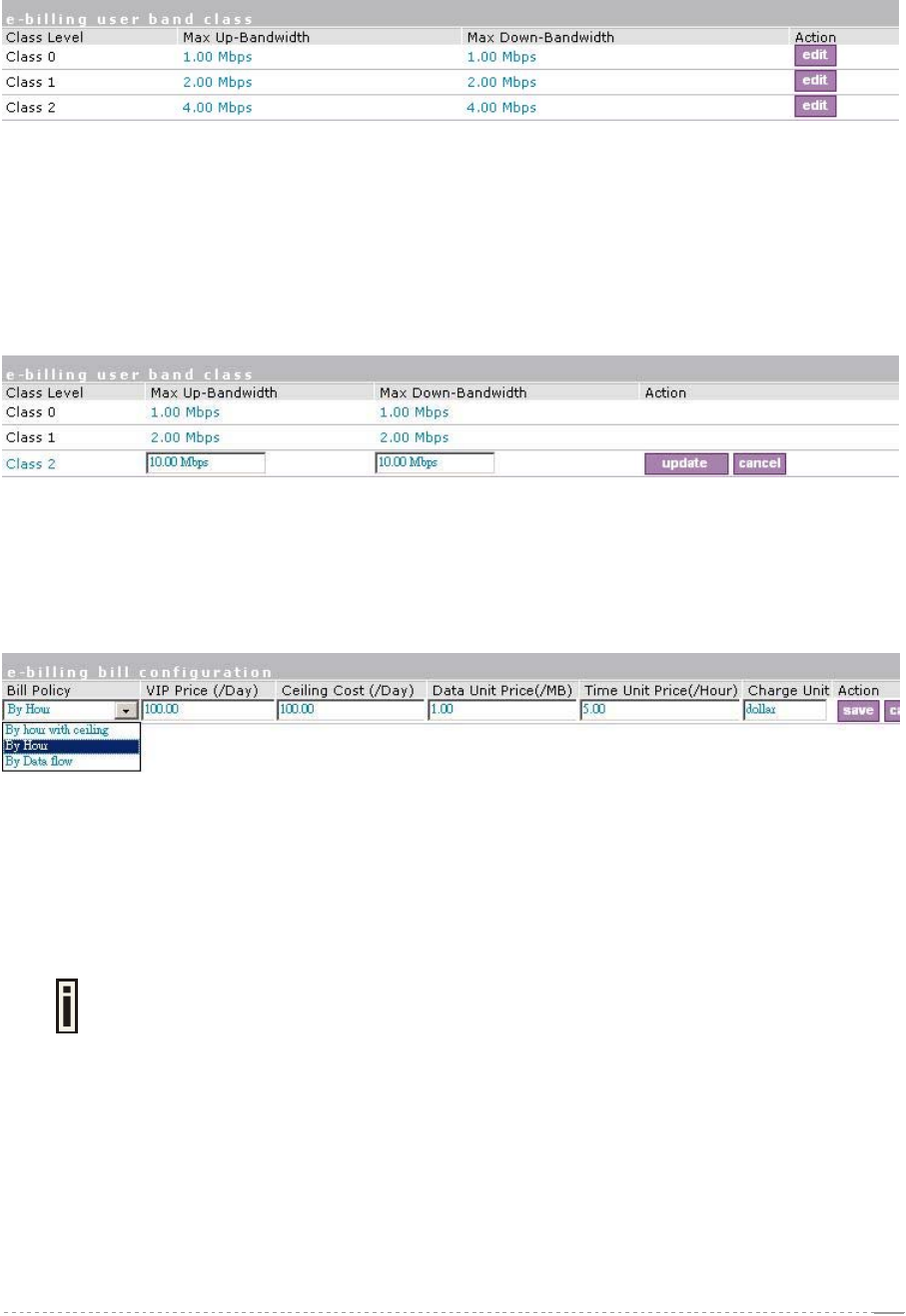
User’s Guide Version 1.0
Built-in AAA | E-Billing | Band Class
BW1330 provide three bandwidth class, administrator can define each class bandwidth:
Figure 223 – Bandwidth class
There are three class level in default.
Class Level - Define the different user level for the download and upload bandwidth.
Max Up-Bandwidth - Maximum upload data for the specified user class level.
Max Down-Bandwidth - Maximum download data for the specified user class level.
Click edit button to change the upload and download bandwidth.
Figure 224 – Bandwidth class
Click the update button to apply change or the cancel button to cancel the modification.
Built-in AAA | E-Billing | Bill setting
Administrator can set the E-Billing billing policy through this sub-menu:
figure 225 – Billing policy
BW1330 supports billing policy of billing by Hour, by Data flow and by hour with ceiling policy.
Administrator need fill a price of each billing unit; the price can be accuracy to two places of decimals.
For time the unit is hour and for data it is Mbytes.
If the “By hour with ceiling” policy is selected, the daily cost of an account will be limit to the ceiling
cost, (PM12:00 as the start time and ending time of one day).
BW1330 will only compute the download data flow if the policy is billing by data
flow.
In “Charge Unit” administrator need fill out the currency unit of the local country.
Administrator and logon user can look into user’s detail billing list via Built-in AAA | E-Billing | user
control menu and click the “bill” button for the detail.
BROWAN Page
121
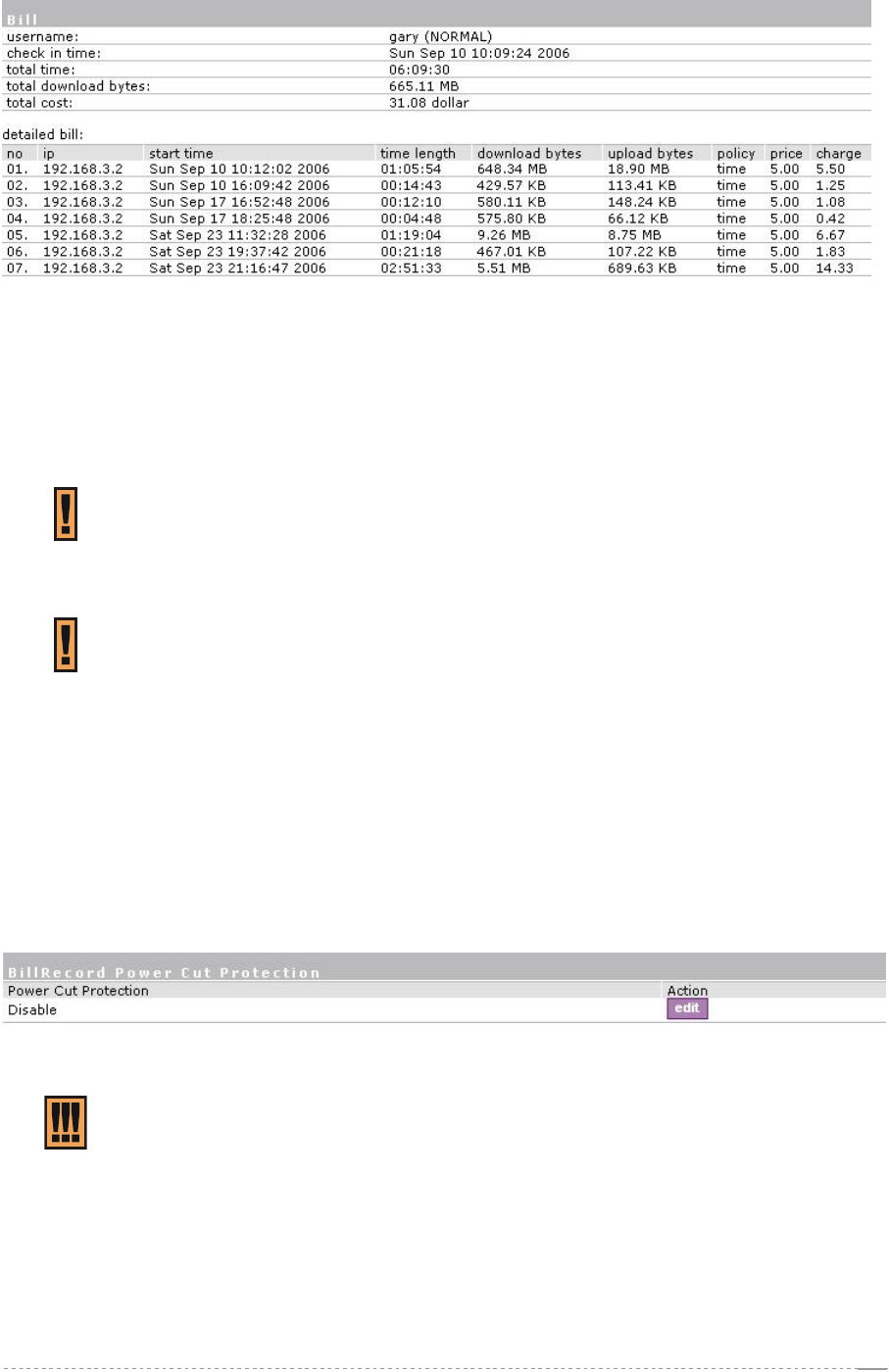
User’s Guide Version 1.0
Figure 226 – Bill detail of an ebilling account
“Start time” means the time when user start this session.
“Time length” means the total time of this session.
“Download bytes” and “upload bytes” means the flow of this session.
The column “charge” show the user cost of each session.
If the bill policy is by hour, the minimum time unit will be minutes, less or equal to
one minute will count as one minute.
After administrator modify the billing policy, sessions only after the time of
modification will take effect while sessions before the time of modification will still
use the old policy to billing.
Built-in AAA | E-Billing| Power cut protection
If power cut protection is disabled, BW1330 only record E-Billing account’s accounting data when
user logout. If there has an accidental power cut-off, the accounting data of this session will be lost; If
the power cut protection is enabled, BW1330 will update each online E-Billing account’s accounting
data to flash disk every “User Accounting Update” which configured in Network Interface | RADIUS |
RADIUS Settings and if BW1330 will automatic restore the last session’s accounting data if an
accidental power cutoff happened.
Figure 227 -- Power cut protection
For power cut protection will frequently write data to flash, so if it is enabled, please
make sure the “user accounting update” which configured in Network Interface |
RADIUS | Settings not less than 600 seconds.
If you don’t need the lost accounting data when accidental power cut off, set the
power cut protection setting to disabled.
BROWAN Page
122
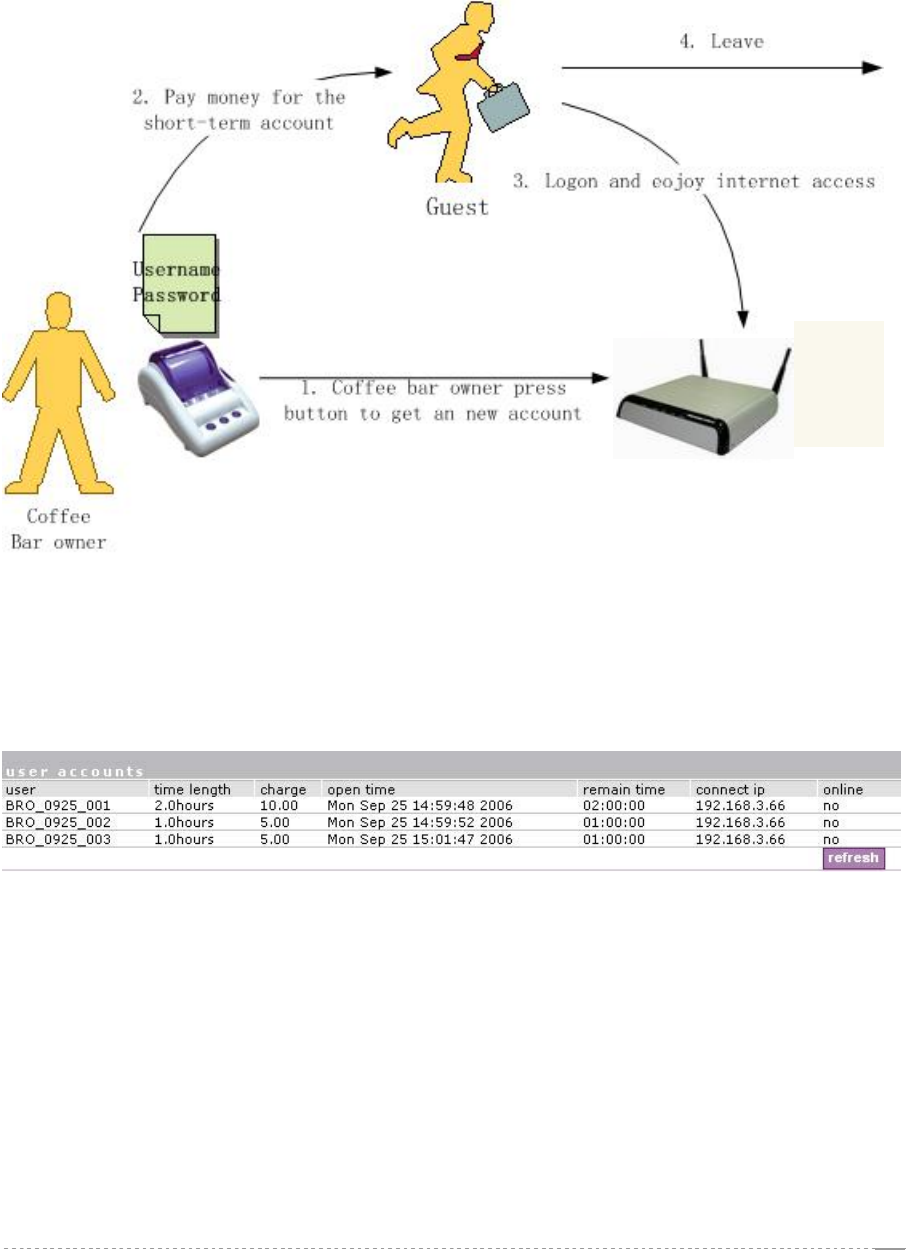
User’s Guide Version 1.0
Built-in AAA | pre-paid
With Browan Communications A-720/A-721 (account printer and converter), user can use the pre-paid
feature. With the scenario descript in the below figure. Venue owner can use this feature create a
Public access operate mode by BW1330 with its printer/A-720 and converter/A-721.
Figure 228 – Pre-paid scenario
Built-in AAA | pre-paid | user account
User account shows the receipts status which has been printed and not expired now.
Figure 229 – Pre-paid user account
User: show the printed pre-paid account name.
Pre-paid account is composed with three parts.
1. The first part is the prefix (first there characters) of Title configuration;
2. The second part is the date when print this receipt;
3. The last part is a sequence number which will increase automatically.
Time length: the total session time of the receipt has.
The session time of a receipt has decided the price of the receipt. The session time is 0.5,
1.0, 2.0, and 3.0 hours and so on. A-710 only can generate receipt with session time of 1 hour;
A-720 can generate receipt with session time from 0.5 to 9 hours.
Charge: show the total charge of the receipt.
BROWAN Page
123
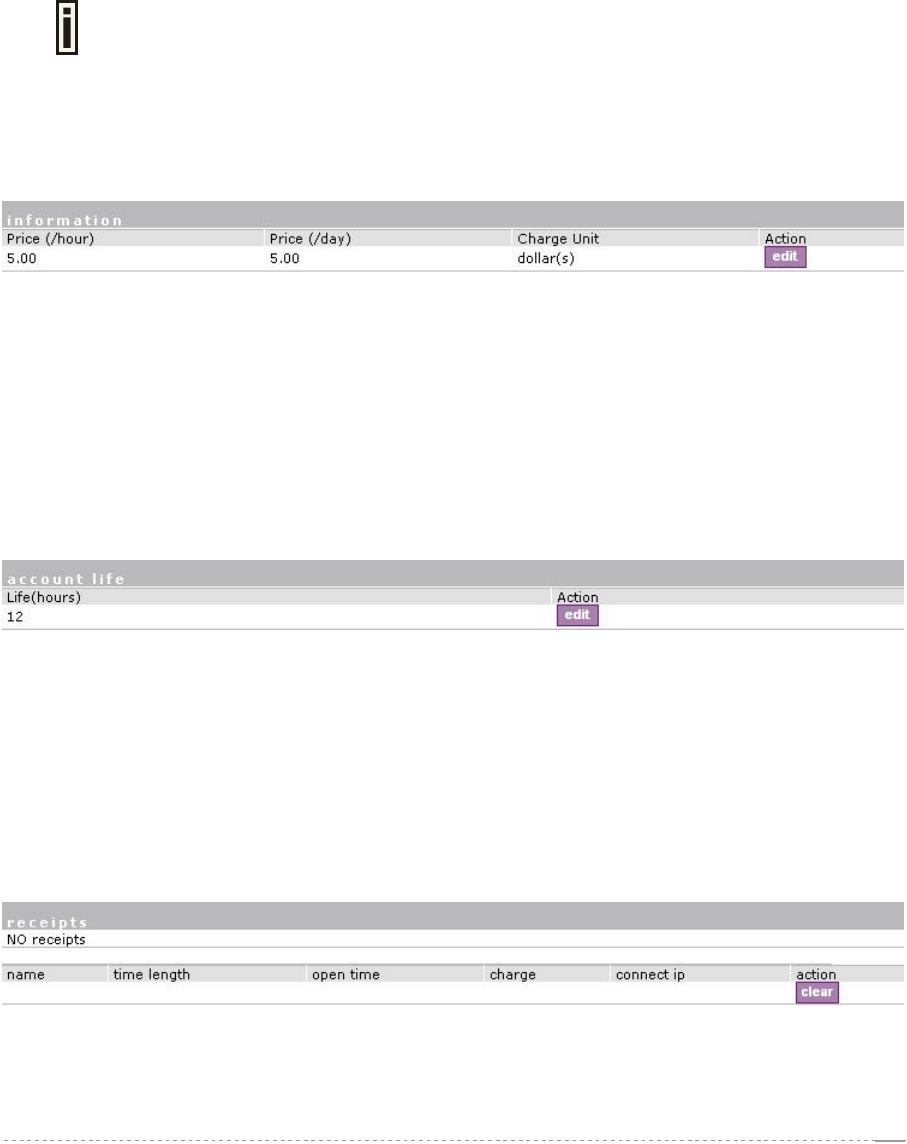
User’s Guide Version 1.0
Open time: The time when the receipt is generated.
Remain time: Remain time of the pre-paid account.
Pre-paid account session time can be consumed by server times. Before the receipt expired
time, this account can logon and logout. And each logon session time will be accumulated.
For example, if a customer buy one hour. He logon and use 20 minutes then he logout and
have a phone call for 20 minutes. After the phone call he can logon and has 40 minutes
session time left.
Online: show if this receipt is in using.
The pre-paid has power cut-off protection function. If there has an accidental power
cut-off, the pre-paid account which generated before accident cut-off can be
restored and still can use.
Built-in AAA | pre-paid | price/unit
Price/unit configure the price of pre-paid account.
Figure 230 – Pre-paid price/unit
Price(/hour) - the price of each hour.(Maximum value is 100,000,000)
Price(/day) - the price of each day. (Maximum value is 1,000,000,000)
Charge Unit: the cash unit.
Click the edit button to change the policy and save it.
Built-in AAA | pre-paid | account life
Account life is to configure the expired time of user.
Figure 231 – Pre-paid account life
Life(hours) - the expire time of user. (Maximum value is 720 hours)
Click edit button to specify the life value and then save it.
Built-in AAA | pre-paid | receipts
Receipts show the printed pre-account, and computed the total cost. It is a history record for printed
receipts, include expired and un-expired receipts. User can delete each history record of receipt.
Figure 232– Pre-paid receipts
BROWAN Page
124
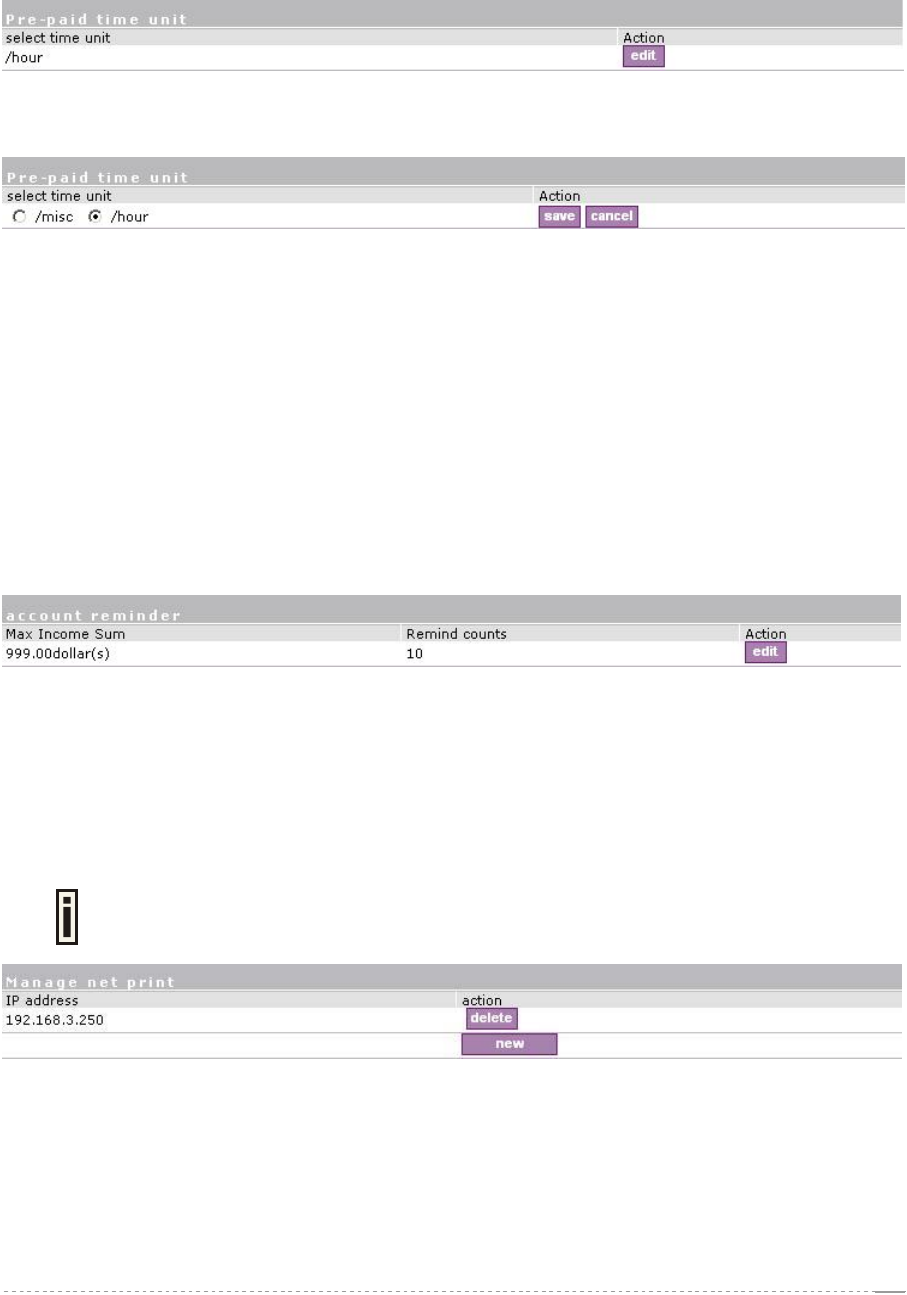
User’s Guide Version 1.0
Built-in AAA | pre-paid | timeunit
Hotspot owner can define the charge time by hour or day for the pre-paid user via Built-in AAA | pre-
paid | timeunit menu.
Figure 233– timeunit
Click the “edit” button to set up the timeunit.
Figure 234– timeunit setting
hour - The charge is by hour. Corresponding to the A-720 printer the keypad 0~9.(0 means half
hour while the keypad 1~9 mean 1~9 hours respectively.)
misc - mix mode by hour and day.Corresponding to the printer keypad which 0 means half hour and
1~5 means 1~5 hours respectively. The keypad 6~9 means 1~4 days respectively.
Built-in AAA | pre-paid | account reminder
The account reminder feature is for reminding hot spot owner to check the income of prepaid
accounts. (Please refer to the Built-in AAA | pre-paid | receipts).
Administrator can set the rating of cash and remind times for reminding himself (herself) to check the
income which bring by prepaid account. After checking, administrator need delete the recorded
receipts history to avoid BW1330 remind again.
Figure 235 – account reminder
Built-in AAA | pre-paid | manage net print
BW1330 supports its account printer with converter to print receipt. Without RS232 DB-9 Connector,
you must connect the printer to BW1330 through the converter connected to the LAN port.
For more detail please refer to the production CD of the converter for the setting
and connection.
Figure 236– net print default IP address
IP address - the IP address of converter(default IP address:192.168.3.250).
delete - delete IP setting.
new - specify a new IP address of converter.
BROWAN Page
125
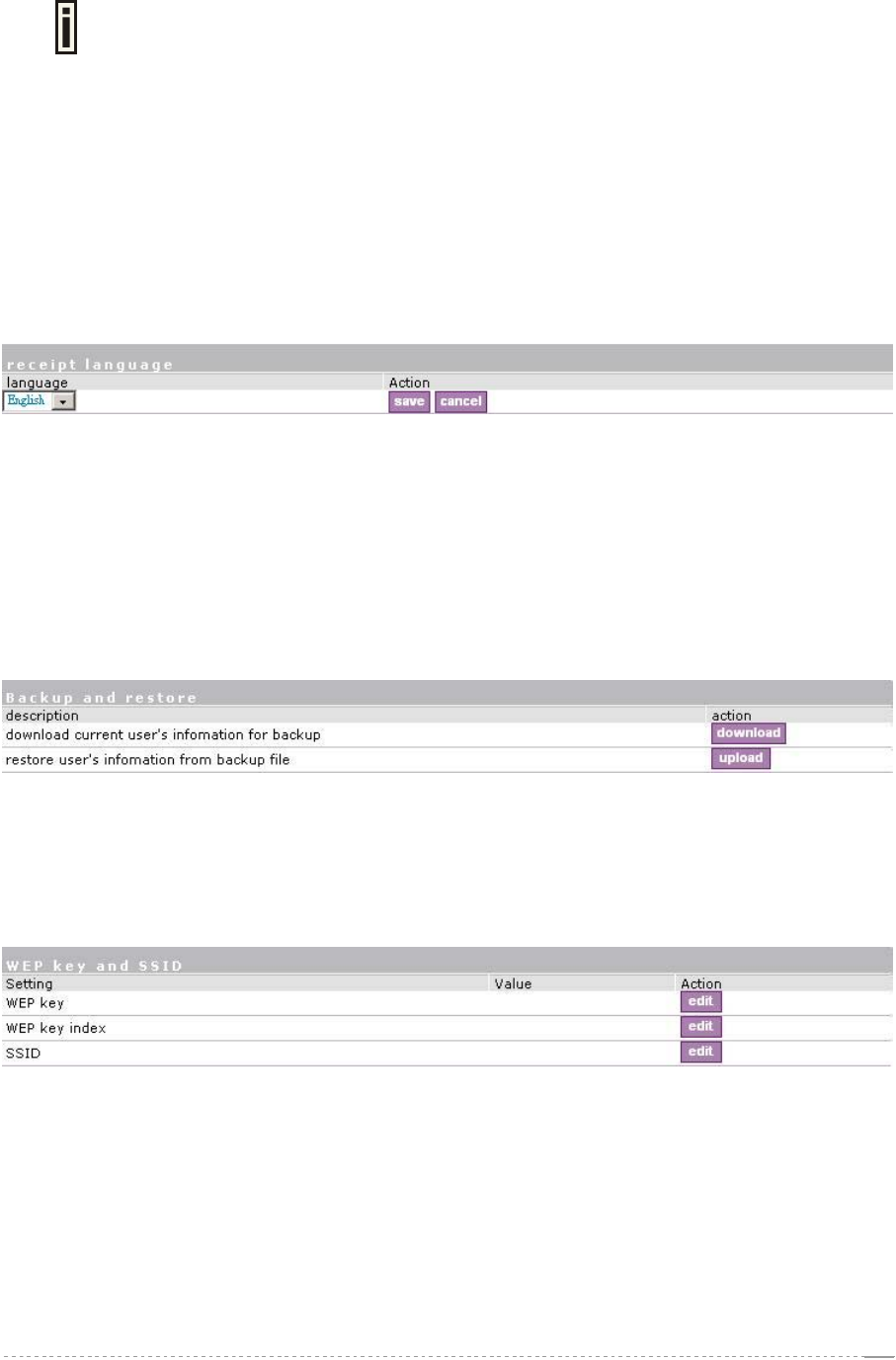
User’s Guide Version 1.0
Up to three IP address can be specified in the net print menu.
Built-in AAA | Configuration
For more detail information showed on the receipt such as the SSID,WEP key,language or title of
receipt use Built-in AAA | Configuration to make configuration.
Built-in AAA | Configuration | Language
The language of printed receipt: Chinese or English.
Figure 237 – Pre-paid receipt language
Built-in AAA | Configuration | Backup and restore
You can save user information locally using the backup and restore menu under the Built-in AAA |
configuration menu:
Click “download” button to backup the E-billing and pre-paid Billing information.
Click “upload” button to restore the backup information.
Figure 238 – E-Billing information backup and restore.
Built-in AAA | pre-paid | WEP key and SSID
The configuration of WEP key and SSID will be printed on the receipt.
Figure 239 – Pre-paid WEP key and SSID configuration
Click the edit button for every column to specify the WEP key and SSID.
Built-in AAA | Configuration | title
Title is the name of a venue. Venue owner can print their venue name and description on each printed
receipt.
BROWAN Page
126
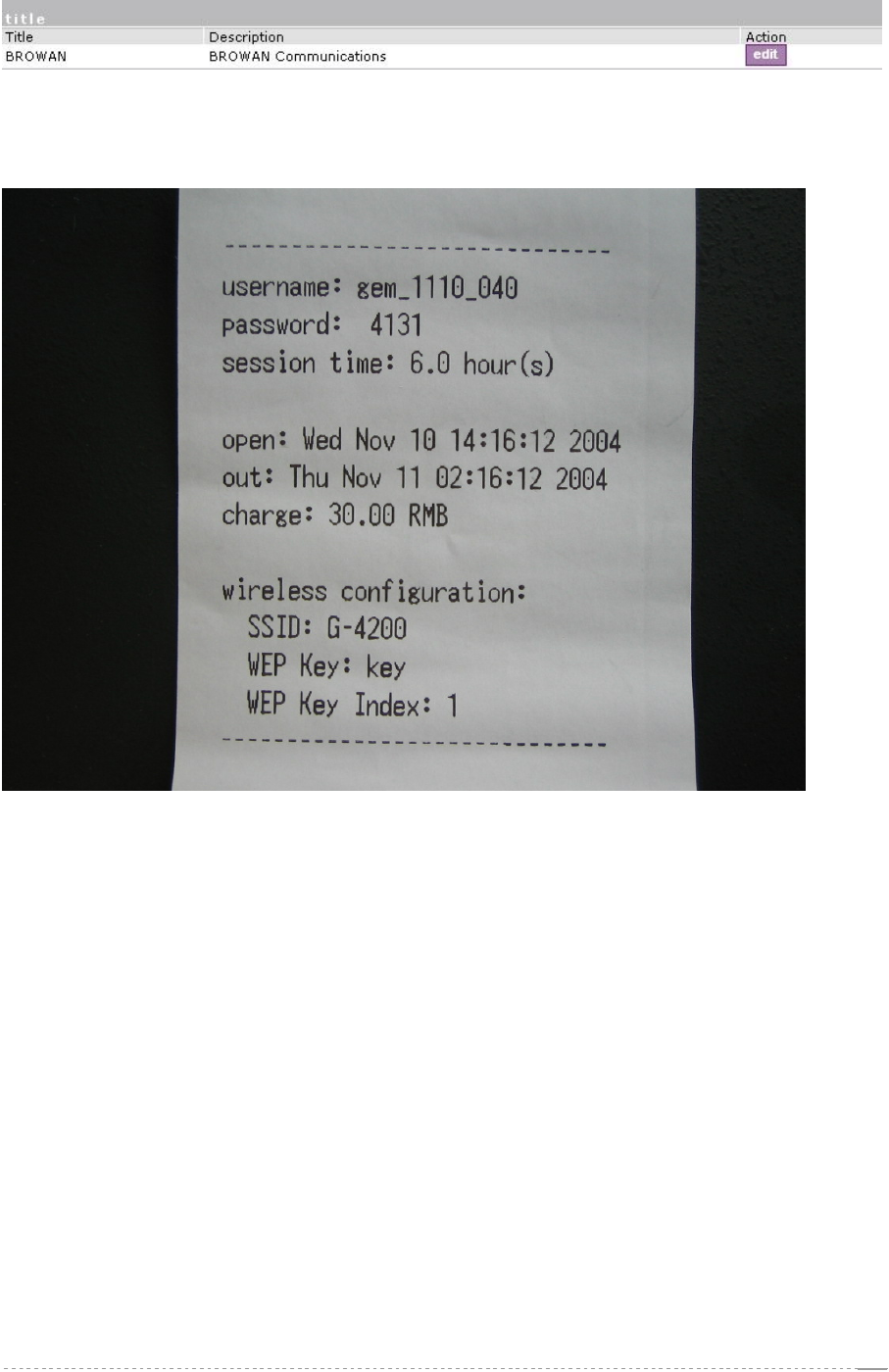
User’s Guide Version 1.0
Figure 240 – Printed receipts title
Pre-paid name will use the format: “Prefix three characters of title name + date + serial number”
Below is an example of printed receipts.
Figure 241 – Pre-paid receipt example
BROWAN Page
127

User’s Guide Version 1.0
BROWAN Page
128
A) Access Controller Specification
Technical Data
Wireless
Standard IEEE 802.11g (OFDM), IEEE 802.11b (DSSS), 2.4GHz ISM band, Wi-Fi
certified
Data Rate 802.11g: 54, 48, 36, 24, 18, 12, 9, 6 Mbps, 802.11b: 11Mbps, 5.5Mbps, 2,
1Mbps (auto fall back)
Client Stations Max. 100 simultaneous client stations(wireless+LAN)
Typical range 50 meters in indoor environments, up to 300m outdoors
Transmit Power Max. 19 dBm
Antennas Two 2.33 dBi dipole antennas, R-TNC connectors.
Encryption WPA, WPA2, WPA-PSK, WEP64, WEP128
WDS Wireless Distribution System
Network and Hotspot Access Control
IP Router with NAT/NAPT, configurable
firewall filters
Hotspot access controller with web browser log-
on (UAM) and 802.1x/EAP support, Smart Client
support, MAC authentication, WISPr compliant
(Wi-Fi alliance)
AAA RADIUS client and proxy server
with EAP support
Extended Universal access method (web browser
log-on) with XML support and walled garden (free
web sites)
Universal address translation and web
proxy support (any client configuration
is accepted)
WISPr compatible log-on via web browser,
SSL/TLS support UAT
VPN client (GRE) IEEE 802.1x authenticator with EAP-SIM, MD-5,
TLS, TTLS, PEAP
WPA support DHCP server, DHCP relay gateway, DHCP client
VPN pass-through Layer 2 user isolation
E-mail redirection Bandwidth management via RADIUS
Interface
WAN One 10/100Mb Ethernet, auto sensing (speed, duplexity, MDI/MDIX),
RJ-45
LAN One 10/100Mb Ethernet port, auto sensing (speed, duplexity, MDI/MDIX),
RJ-45, 802.1q VLAN support
WLAN Two R-TNC antenna connectors
Management
Interfaces HTTPs, SSH, Telnet, SNMP (MIB II, Ethernet MIB, bridge MIB, private
MIB)
Software Update Remote software update via HTTP, HTTPs or FTP
Reset Remote reset / Manufacturing reset
Console RS-232 DB-9 Connector
Physical Specification
Appendix

User’s Guide Version 1.0
BROWAN Page
Dimension 195 mm x 160 mm x 27 mm
Weight 450g
Environment Specification
Temperature Humidity
Operating 0 to 55°C 10 % to 95%, non-condensing
Power Supply
External Input:100-230V AC, 50/60Hz/Output:12V/1A DC
LEDs
5 LEDs Power, Online, WAN, LAN, WLAN
Warranty
3 years
Package Contents
BW1330 Hotspot Access Point x 1 External power supply, 100-230 V, 50/60 Hz x 1
RJ-45 Ethernet cable x1 Printed warranty note x 1
Detachable antenna(R-TNC connector)x2 US power cord x 1
CD-ROM with software and
documentation x 1
EU power cord x 1
Related Products
129
BW2250 Outdoor dual radio
Operator Access Point/Bridge
P-520r 54Mb Operator Access Point Access Points:
BW1250 Dual radio Operator Access Point
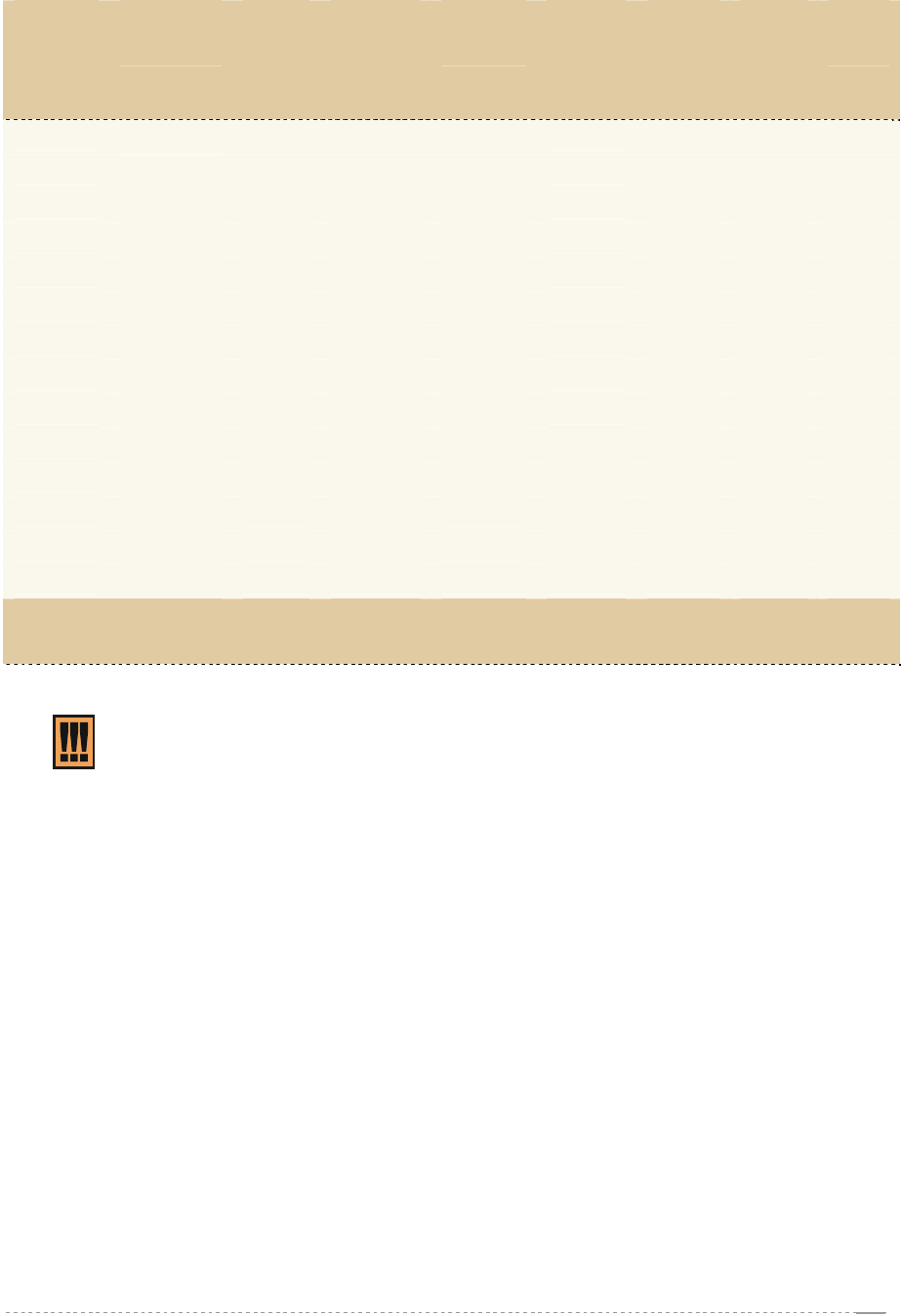
User’s Guide Version 1.0
B) Regulatory Domain/Channels
Channel
s
Identifier
s
Frequency
in MHz USA,
Canad
a
(FCC)
European
Union
(CE/ETSI)
WORLD
(CE/FCC)
France China Japan Manua
l
1 2412 • • • — • • •
2 2417 • • • — • • •
3 2422 • • • — • • •
4 2427 • • • — • • •
5 2432 • • • — • • •
6 2437 • • • — • • •
7 2442 • • • — • • •
8 2447 • • • — • • •
9 2452 • • • — • • •
10 2457 • • • • • • •
11 2462 • • • • • • •
12 2467 — • — • • • •
13 2472 — • — • • • •
14 2484 — — — • •
— —
BROWAN Page
130
Maximum Power
Levels 18dBm 20dBm 20dBm 20dBm 20dBm 20dBm 20dB
m
Mexico is included in the Americas regulatory domain; however, channels 1
through 8 are for indoor use only while channels 9 through 11 can be used indoors
and outdoors. Users are responsible for ensuring that the channel set configuration
complies with the regulatory standards of Mexico.

User’s Guide Version 1.0
C) CLI Commands and Parameters
Network Commands
network
configuration Network Interfaces configuration.
dhcp Dynamic Host Configuration Protocol services configuration.
dns DNS Server settings.
radius Configuration set for changing RADIUS Server settings.
tunnels Tunnels configuration commands.
network configuration
bridge Bridge configuration
interface Network Interfaces configuration.
portforward Port forwarding setup.
routes Static IP routing settings.
subnet Management subnet configuration.
vlans VLANs configuration.
network configuration bridge
configuration Bridge configuration.
ports Bridge ports configuration.
network configuration bridge
configuration
<action> Action to take upon a bridge interface: A(dd), E(dit), D(elete).
<id> Bridge interface identifier (number)
-a <aging> Bridge aging time.
-g <garbage> Garbage collector interval.
-t <stp> Spanning Tree Protocol status: enabled or disabled.
-p <priority> Bridge priority: low, medium or high.
-d <delay> Bridge forward delay.
-h <hello> Bridge hello time.
-e <age> Bridge maximum age.
network configuration bridge
ports
<bridge> Bridge name to add or delete interface (port) from.
<action> A(dd) or D(elete) interface(port) from bridge.
-i <interface> Interface (port) name.
-c <cost> Port path cost in the bridge interface.
-p <priority> Port priority in the bridge interface.
network configuration
interface
<interface> Standard UNIX interface name. This name cannot be changed.
BROWAN Page
131

User’s Guide Version 1.0
BROWAN Page
-s <status> The interface status. Possible values are enabled and disabled.
-a <ip_address> Interface IP address in digits and dots notation, e.g. 192.168.2.27.
-m <netmask> Interface subnet mask e.g. 255.255.255.0.
Interface gateway in digits and dots notation or name of other
interface.
-g <gateway>
The status of dhcp client for the interface. May have values
enabled and disabled. Can be used with WAN interface only.
-d <dhcpclient>
-q <masquerade> Masquerade status for interface: enabled or disabled.
-u <authentication> Authentication status on interface: enabled and disabled.
-v <visitor_access> Visitor access for interface: values enabled and disabled.
network configuration
portforward
<action> Action to take upon Port Forwarding entry: A(dd), E(dit), D(elete).
<id> Port Forwarding entry id. Needed with actions E(dit) and D(elete).
-s <status> PortForwarding rule status: enabled or disabled.
-p <protocol> Rule protocol.
-a <ip> Source ip address.
-l <port> Source port.
-d <ip> Destination ip address.
-r <port> Destination port.
network configuration routes
Action to take upon the route. May have values A(dd), E(dit),
D(elete).
<action>
<id> Route id. Needed only with actions E and D
-s <status> Route status. May have values enabled or disabled.
-d <device> Interface name.
-t <target> Target ip address.
-m <netmask> Target netmask.
-g <gateway> Gateway for the target address.
network configuration subnet
<interface> Interface name on which the management subnet is configured.
-s <status> Interface ip address for management subnet.
-a <ip_address> Interface ip address for management subnet.
-m <netmask> Interface netmask for management subnet.
Network from which users are allowed to access management
subnet.
-n <filterNetwork>
Netmask of network from which users are allowed to access
management subnet.
-t <filterNetmask>
network configuration vlans
<action> Action to take upon VLAN interface: A(dd), E(dit), D(elete).
<id> VLAN interface id. Needed only with action A.
Name of LAN interface on which VLAN interface exists. Needed
only with action A.
<interface>
<name> Name of VLAN interface. Needed only with actions E and D.
132

User’s Guide Version 1.0
BROWAN Page
Switch control dedicated port: disabled/LAN1/LAN2/LAN3/LAN4.
Needed only with actions A and E.
<dedicate>
network dhcp
<interface> Interface name for DHCP server instance.
Status of DHCP server for interface. May be server, relay or
disabled.
-s <status>
Start of IP address range supported for DHCP service. Needed
only with server status.
-f <from>
End of IP address range supported for DHCP service. Needed
only with server status.
-t <to>
WINS Address (Windows Internet Naming Service Address) if it is
available on the network. Needed only with server status.
-w <wins>
-l <lease_time> DHCP Server lease time. Needed only with server status.
-d <domain> DHCP domain name. Needed only with server status.
Circuit ID - a unique NAS identifier. MAC address will be used by
default. Needed only with relay status.
-c <circuit_id>
-n <dns_list> List of up to two DNS servers IP addresses.
network dns
-p <nameserver> DNS primary Server IP address.
-s <nameserver> DNS secondary Server IP address.
-d <nameserver> DNS Domain Name.
-h <nameserver> DNS Host Name.
Network Radius Commands
network radius
accounting_log For sending RADIUS accounting via syslog.
proxy RADIUS Proxy configuration.
servers Up to 32 different RADIUS servers' configuration.
settings General RADIUS settings configuration.
wisp WISP information and setup.
network accounting_log
Remote accounting log status. Possible values are enabled or
disabled.
-r <status>
-a <host> The host IP address where to send the accounting information.
network radius proxy
-s <status> RADIUS Proxy status: enabled or disabled.
-a <port> RADIUS Proxy authentication port.
-c <port> RADIUS Proxy accounting port.
-t <time> RADIUS Proxy accounting detection timeout
network radius servers
accounting Accounting RADIUS servers' configuration.
authentication Authentication RADIUS servers' configuration.
backup Accounting information backup servers configuration.
network radius servers
133

User’s Guide Version 1.0
BROWAN Page
accounting
<id> RADIUS server id.
-a <ip_address> RADIUS server IP address used for Radius accounting.
-p <port> RADIUS server port used for Radius accounting.
Shared secret key for accounting (must be the same on RADIUS
server and RADIUS client).
-s <secret>
network radius servers
authentication
Action to take uppon radius server. May have values A(dd), E(dit),
D(elete).
<action>
<id> RADIUS server id.
-n <name> RADIUS server name.
-a <ip_address> RADIUS server IP address.
-p <port> RADIUS server port.
Shared secret key (must be the same on RADIUS server and
RADIUS client).
-s <secret>
Sets the server as default. Possible values: yes. Note: there can
be only one default Radius server.
-d <default>
-r <status> Reverse accounting. May have values enabled or disabled.
Strip WISP name before sending to RADIUS. May have values
enabled or disabled.
-w <status>
UAM authentication method for RADIUS server. May have values
pap, chap, mschap1 and mschap2.
-u <method>
network radius servers
backup
<id> RADIUS server id.
If RADIUS Backup Server feature is on. May have values enabled
or disabled.
-b <status>
-a <ip_address> Backup RADIUS server IP address used for Radius accounting.
-p <port> Backup RADIUS server port used for Radius accounting.
Shared secret key for backup server(must be the same on
RADIUS server and RADIUS client).
-s <secret>
network radius settings
-r <retries> Retry count of sending RADIUS packets before giving up.
Maximal amount of time before retrying RADIUS packets (in
seconds).
-t <timeout>
-n <nas> NAS Server identification string.
Amount of time from user side (no network carrier) before closing
the connection (in seconds).
-o <user_timeout>
Period after which server should update accounting information
(in seconds).
-a <acct_update>
Retry time period in which server should try to update accounting
information before giving up (in seconds).
-c <acct_retry>
Amount of user inactivity time, before automatically disconnecting
user from the network (in seconds).
-i <idle>
-u <bandwidth> Default Radius user upload bandwidth.
134

User’s Guide Version 1.0
BROWAN Page
-d <bandwidth> Default Radius user download bandwidth.
network radius wisp
<action> A(dd), D(elete)
<id> WISP Id. Usable only with D action.
<name> WISP name. Usable only with A action.
<radius_id> WISP Radius server id (from Radius authentication server list).
Usable only with A action.
<interface> Interface name to which the WISP should be bound or none.
Usable only with A action.
Network Tunnels Commands
network tunnels
gre GRE client setup.
ppp PPTP, PPPoE and GRE setup.
pptp4vpn PPTP for VPN setup.
network tunnels gre
<action Action to take upon GRE tunnel: A(dd), E(dit), D(elete).
<id> GRE tunnel id. Needed only with action E and D.
<status> GRE tunnel status. Needed only with action A and E.
<remote> Remote host ip. Needed only with actions A and E.
network tunnels ppp
-s <status> Status: disabled/PPTP/PPPoE/GRE.
-n <name> PPPoE/PPTP username.
-p <password> PPPoE/PPTP password.
-e <encryption>: PPPoE/PPTP encryption status: enabled or disabled.
-a <server> PPTP server ip address/GRE remote address.
-i <ip> GRE interface address.
-m <netmask> GRE interface netmask.
network tunnels pptp4vpn
<action> A(dd), D(elete) or E(dit) entry.
-c <channel> PPTP channel. Used only with A and E actions.
-s <server> PPTP server ip address. Used only with A and E actions.
-u <username> PPTP username. Used only with A and E actions.
-p <password> PPTP password. Used only with A and E actions.
-e <encryption> PPTP encryption status: enabled or disabled. Used only with A
and E actions.
-a <network> PPTP remote network address. Used only with A and E actions.
-m <netmask> PPTP remote network netmask. Used only with A and E actions.
User Commands
user
administrator Administrator login and password change.
connected Connected users list.
135

User’s Guide Version 1.0
BROWAN Page
start_page Definition of first URL after user login.
walled_garden Free Web sites list.
webproxy Web proxy configuration.
user administrator
Enter for wizard Follow the wizard and complete administrator settings changes.
user connected
<action> D(etail) user statistics for or L(ogout) user with specified ip.
<ip> User ip address.
user start_page
<url> The web page to which the user is redirected after login.
user walled_garden
autoupdate Configures automated walled garden update.
host Configures free web sites that are not displayed to users.
url Configure free web sites that are displayed to users.
user walled_garden
autoupdate
-s <status> Automated update status: enabled or disabled.
-u <url> Update URL.
-i <interval> Update interval in hours.
user walled_garden host
Action to take on free web site. May have values A(add), E(edit),
D(delete).
<action>
Walled Garden entry id. Used only with E(dit) and D(elete)
actions.
<id>
-h <host> Host address.
Network port, or port range i.e. 25-50, or use ‘0’ or 'all' for all ports
that may be used to reach the host.
-p <port>
-t <type> Used protocol type. May have values tcp or udp.
-m <netmask> Host subnet mask e.g. 255.255.255.255.
user walled_garden url
Action to take on free web site. May have values A(add), E(edit),
D(delete).
<action>
Walled Garden entry id. Used only with E(dit) and D(elete)
actions.
<id>
-u <url> URL address used for link.
-s <display> URL description visible for user.
user webproxy
-s <status> Web proxy status: enabled or disabled.
-a <port> [<port>... [<port>]] Add list of Web proxy ports.
-d <port> [<port>... [<port>]] Delete list of Web proxy ports.
136

User’s Guide Version 1.0
System Commands
system
access System access configuration.
configuration System configuration.
system access
aaa Multimode settings.
Allow or deny management access depending on user network
address.
control
firewall Firewall configuration.
iplogging Enabling or disabling IP request logging.
snmp Configuration of SNMP service.
telnet Enabling or disabling of telnet protocol.
uat Universal Address Translation of all IP and proxy settings.
system configuration
clock Manual setting of internal device clock
ntp Configuration of Network time Protocol service.
pronto Pronto compatibility agent configuration.
syslog For sending system and debug messages via syslog protocol.
trace Displays the last logged messages.
upgrade Auto firmware upgrade configuration.
System Access Commands
system access aaa
<interface> Interface to set AAA on.
Either disabled or space separated list of modes. Modes may be:
uam, 8021x, mac, proxy.
-m <mode_list>
Mac authentication mode password usage: 'radius' - use radius
shared secret key, 'user' - use user defined password.
-u <use_password>
-p <password> User defined mac authentication password.
system access control
Action to take upon management access entry: A(dd), E(dit),
D(elete) or default.
<action>
Management access entry id. Needed only when editing or
deleting entry.
<id>
Services for which the policy should be set: ssh, snmp, telnet or
all.
-s <service>
-a <ip/bitmask> 'all' or network ip address and bitmask to (dis)allow service to.
-p <policy> Management access policy: allow or deny(default is deny).
system access firewall
Action to take upon the rule: A(dd), I(nsert), E(dit), R(emove),
move U(p), move D(own).
<action>
<id> Firewall rule index. Not needed when adding a new rule.
-c <type> Rule type: input, output, forward.
BROWAN Page
137

User’s Guide Version 1.0
BROWAN Page
-t <policy> Rule policy: accept, reject, drop.
-p <protocol> Rule protocol: tcp, udp, icmp, all.
-si <interface> Rule source interface.
-sa <ip_address> Rule source Ip address.
-sm <netmask> Rule source netmask.
-sp <port> Rule source port.
-di <interface> Rule destination interface.
-da <ip_address> Rule destination Ip address.
-dm <netmask> Rule destination netmask
-dp <port> Rule destination port.
Firewall status: enabled or disabled. Must be the only parameter
used with command.
-s <status>
system access iplogging
<status> Change IP request logging service status: enabled or disabled.
system access snmp
proxies SNMP proxies settings.
settings SNMP service settings.
traps SNMP traps settings.
users SNMP users settings.
system access snmp proxies
<action> Action to take upon SNMP proxy entry: A(dd), E(dit) or D(elete).
<id> Entry id. Needed only with Edit and Delete actions.
Proxy type. May have values v1, v2c. Can be used only when
adding or editing proxy.
-t <type>
-a <ip_address> Proxy ip address.
-c <community_name> Proxy community name.
-l <oid_local> Proxy local OID.
-r <oid_target> Proxy target OID.
system access snmp settings
-s <status> Status of SNMP service.
-n <name> System name.
-l <location> Location of the device.
-c <contact> Contact information.
-b <public_name> Public name of SNMP service.
-r <private_name>: Private name of SNMP service.
system access snmp traps
<action> Action to take upon SNMP trap entry: A(dd), E(dit) or D(elete)
<id> Entry id. Needed only with Edit and Delete actions.
-c <community> SNMP community string.
-a <ip_address> SNMP trap host address.
-p <port> SNMP trap port.
-t <type> SNMP trap type: v1, v2 or inform.
138

User’s Guide Version 1.0
BROWAN Page
system access snmp users
<id> User id.
-n <name> SNMP user name.
-p <password> SNMP user password.
system access telnet
<status> Change telnet service status: enabled or disabled.
system access uat
<interface> Active LAN interface.
-s <status> UAT status on interface.
-a <ip_from> UAT address pool start.
-m <ip_to> UAT address pool end.
System Configuration Commands
system configuration
clock Manual setting of internal device clock.
ntp Configuration of Network time Protocol service.
syslog For sending system and debug messages via syslog protocol.
trace Displays the last logged messages.
system configuration clock
<date> New date values in YYYY.MM.DD format.
<time> New time in hh:mm format.
<zone> New time zone (time from GMT in minutes).
system configuration ntp
<action> Action: A(dd), E(dit), D(elete) server or set NTP S(tatus).
<id> Server id. Needed only with E and D actions.
-a <server> NTP server address.
NTP service status: enabled or disabled. Needed only with S
action.
-s <status>
system configuration pronto
-s <status> Pronto compatibility agent status: enabled or disabled.
-u <server_url> HNS server url in format host:port.
Heartbeat interval in seconds, 'disabled' or 'server' to obtain it
from the server.
-h <interval>
-a <remote_host> Remote host ip address.
-p <remote_port> Remote host port.
system configuration syslog
-s <status> Syslog status. Possible values are enabled or disabled.
The host IP address where to send the syslog. Needed only when
enabling syslog.
-h <host>
The lowest level of messages that will be logged. Possible levels:
debug, info, warning, error, fatal.
-l <level>
system configuration trace
139

User’s Guide Version 1.0
BROWAN Page
clear Clears trace history.
size <number> Sets trace history size.
Sets level of trace messages. Possible levels: debug, info,
warning, error, fatal.
level <level>
system configuration upgrade
-s <status> Firmware auto-upgrade status: enabled or disabled.
-u <url> URL to get firmware for autoupgrade from.
-i <interval> Interval in hours between auto-upgrade checks.
-d <delay> Delay in hours after the interval has passed.
Status Commands
status
device General system information.
network Network information.
service Services information.
Connection Commands
connection
email Outgoing Main (SMTP) Redirection settings.
supervision Settings for station availability monitoring with ARP-Pings.
connection email
<status> SMTP redirection status: enabled or disabled.
<host> New SMTP server host IP address.
<port> New port number.
connection supervision
<seconds> <number> ARP-Ping interval in seconds and failure number after reaching
which user is automatically logged out.
140

User’s Guide Version 1.0
D) Location ID and ISO Country Codes
This list states the country names (official short names in English) in alphabetical order as given in
ISO 3166-1 and the corresponding ISO 3166-1-alpha-2 code elements.
It lists 239 official short names and code elements.
Location
ID Country Location
ID Country
AF Afghanistan LI Liechtenstein
AL Albania LT Lithuania
DZ Algeria LU Luxembourg
AS American Samoa MO Macao
AD Andorra MK Macedonia, the former Yugoslav
republic of
AO Angola MG Madagascar
AI Anguilla MW Malawi
AQ Antarctica MY Malaysia
AG Antigua and Barbuda MV Maldives
AR Argentina ML Mali
AM Armenia MT Malta
AW Aruba MH Marshall islands
AU Australia MQ Martinique
AT Austria MR Mauritania
AZ Azerbaijan MU Mauritius
BS Bahamas YT Mayotte
BH Bahrain MX Mexico
BD Bangladesh FM Micronesia, federated states of
BB Barbados MD Moldova, republic of
BY Belarus MC Monaco
BE Belgium MN Mongolia
BZ Belize MS Montserrat
BJ Benin MA Morocco
BM Bermuda MZ Mozambique
BT Bhutan MM Myanmar
BO Bolivia NA Namibia
BA Bosnia and Herzegovina NR Nauru
BW Botswana NP Nepal
BV Bouvet island NL Netherlands
BR Brazil AN Netherlands Antilles
IO British Indian ocean territory NC New Caledonia
BN Brunei Darussalam NZ New Zealand
BG Bulgaria NI Nicaragua
BF Burkina Faso NE Niger
BROWAN Page
141

User’s Guide Version 1.0
BROWAN Page
BI Burundi NG Nigeria
KH Cambodia NU Niue
CM Cameroon NF Norfolk island
CA Canada MP Northern Mariana islands
CV Cape Verde NO Norway
KY Cayman islands OM Oman
CF Central African republic PK Pakistan
TD Chad PW Palau
CL Chile PS Palestinian territory, occupied
CN China PA Panama
CX Christmas island PG Papua new guinea
CC Cocos (keeling) islands PY Paraguay
CO Colombia PE Peru
KM Comoros PH Philippines
CG Congo PN Pitcairn
CD Congo, the democratic republic of the PL Poland
CK Cook islands PT Portugal
CR Costa Rica PR Puerto Rico
CI Côte d'ivoire QA Qatar
HR Croatia RE Réunion
CU Cuba RO Romania
CY Cyprus RU Russian federation
CZ Czech republic RW Rwanda
DK Denmark SH Saint Helena
DJ Djibouti KN Saint Kitts and Nevis
DM Dominica LC Saint Lucia
DO Dominican republic PM Saint Pierre and Miquelon
EC Ecuador VC Saint Vincent and the grenadines
EG Egypt WS Samoa
SV El Salvador SM San Marino
GQ Equatorial guinea ST Sao tome and Principe
ER Eritrea SA Saudi Arabia
EE Estonia SN Senegal
ET Ethiopia SC Seychelles
FK Falkland islands (malvinas) SL Sierra Leone
FO Faroe islands SG Singapore
FJ Fiji SK Slovakia
FI Finland SI Slovenia
FR France SB Solomon islands
GF French Guiana SO Somalia
PF French Polynesia ZA South Africa
TF French southern territories GS South Georgia and the south
142

User’s Guide Version 1.0
BROWAN Page
sandwich islands
GA Gabon ES Spain
GM Gambia LK Sri Lanka
GE Georgia SD Sudan
DE Germany SR Suriname
GH Ghana SJ Svalbard and Jan Mayan
GI Gibraltar SZ Swaziland
GR Greece SE Sweden
GL Greenland CH Switzerland
GD Grenada SY Syrian Arab republic
GP Guadeloupe TW Taiwan, province of china
GU Guam TJ Tajikistan
GT Guatemala TZ Tanzania, united republic of
GN Guinea TH Thailand
GW Guinea-Bissau TL Timor-leste
GY Guyana TG Togo
HT Haiti TK Tokelau
HM Heard island and McDonald islands TO Tonga
VA Holy see (Vatican city state) TT Trinidad and Tobago
HN Honduras TN Tunisia
HK Hong Kong TR Turkey
HU Hungary TM Turkmenistan
IS Iceland TC Turks and Caicos islands
IN India TV Tuvalu
ID Indonesia UG Uganda
IR Iran, Islamic republic of UA Ukraine
IQ Iraq AE United Arab emirates
IE Ireland GB United kingdom
IL Israel US United states
IT Italy UM United states minor outlying islands
JM Jamaica UY Uruguay
JP Japan UZ Uzbekistan
JO Jordan VU Vanuatu
KZ Kazakhstan Vatican city state see holy see
KE Kenya VE Venezuela
KI Kiribati VN Viet nam
KP Korea, democratic people's republic
of VG Virgin islands, British
KR Korea, republic of VI Virgin islands, u.s.
KW Kuwait WF Wallis and Futuna
KG Kyrgyzstan EH Western Sahara
LA Lao people's democratic republic YE Yemen
143

User’s Guide Version 1.0
BROWAN Page
LV Latvia YU Yugoslavia
LB Lebanon Zaire see Congo, the democratic
republic of the
LS Lesotho ZM Zambia
LR Liberia ZW Zimbabwe
LY Libyan Arab Jamahiriya
144

User’s Guide Version 1.0
E) User Pages Templates Syntax
In this section you will find syntax for the writing of the user pages with examples for the writing of
XSL templates. The BW1330 web server creates XML, having data inside its structure:
Example:
<?xml version="1.0"?>
<Gemtek>
<Header Script_Name="login.user" Title="Login" charset="; charset=ISO8859-
1" language="en"/>
<Data nasid="TestLab" version=" BW1330" help="images/help.html"
ip="192.168.4.1"
mac="00923456789A" original_url="https://192.168.4.4:7777/login.user";
type="2" username="g1">
<entry descr="Gemtek Baltic" id="0" url="http://www.gemtek.lt"/>;
<entry descr="Gemtek Systems, Inc." id="1" url="http://www.gemtek-
systems.com"/>;
</Data>
<WISPAccessGatewayParam MessageType="120" ResponseCode="100">
<entry ReplyMessage="Your password has expired."/>
</WISPAccessGatewayParam>
<Errors id="4102"/>
</Gemtek>
Current script filename (to be used in forms action attribute) can be located in the XML tree at:
/Gemtek/Header/@Script_Name
Page title at:
/Gemtek/Header/@Title
Custom char set (if enabled on administration pages) for user pages at:
/Gemtek/Header/@charset
Welcome.xsl
Welcome page is the first page that the user sees while not registered on the network. This page
provides welcome text to the user who is connected to the controller and supplies a link to the login
page.
Attribute in XML tree at /Gemtek/Data/@cmd defines the link to the login page. This link should be
used to point the user from the welcome screen to login screen. The Welcome page also lists
defined walled garden entries, informing the user where to browse without registering on the network.
Walled Garden information is located in the XML tree under /Gemtek/Data with multiple "entry"
branches. These branches have the following attributes:
descr - website description;
url - website URL;
id - website id for BW1330 configuration, which is not needed for the user connecting to the
network through the BW1330.
Login.xsl
Login page appears when the user is not registered to the network and tries to open a webpage. The
user proceeds to the login page, following the link from the welcome page. The Login page has
variables that can be used:
/Gemtek/Header/@Script_Name - script name to send back to the BW1330 user login information;
/Gemtek/Data/@username - the username to be entered into the user name field – usually the
name the user entered before while unsuccessful in registering on the network;
BROWAN Page
145

User’s Guide Version 1.0
/Gemtek/Data/@ip - detected user IP from which he/she tries to register on the network;
/Gemtek/Data/@mac - detected users MAC address;
/Gemtek/Errors/@id - returned error code, which can be as follows:
error description
4101 Failed to authorize.
4102 Login or/and password incorrect.
4103 Network connection failed.
4104 Accounting error.
4105 Unknown authorization error.
4106 Could not get redirection URL.
4107 Already logged in.
/Gemtek/Data/@type - returns to BW1330 response for login request. Type values are as follows:
error description
0 Ok - logged in, redirect user to start page
1 Failed to authorize
2 Login or/and password incorrect
3 Network connection failed
4 Accounting error
5 User already logged in
It is advisable to first check the error codes, because they return more precise information. Branch
"Type" returns RADIUS server response, which gives additional information about the user status.
This can help in detecting whether the user is just logged in or has come to this page while already
logged-in.
/Gemtek/WISPAccessGatewayParam/entry/@ReplyMessage - the RADIUS server response
message on user logon [optional]. This parameter supports multiple messages.
This optional RADIUS Reply-Message's could provide more detailed information, why user logon
failed.
/Gemtek/Data/@cmd - link to logout page. The logout page displays network usage statistics and
provides the logout from the network function.
/Gemtek/Data/@url - the URL of start page to where the user is redirected after successful login.
Usually it can be the website of the company or organization providing the BW1330 controller and
configuring the users to visit their website.
/Gemtek/Data/@help - link to help page regarding how the user should register on the network.
When the user clicks the login button, information is sent to: /Gemtek/Header/@Script_Name
location with following information:
username - user name to register to network;
password - user password.
When the form is submitted, user information is checked and indication of success or failure is
returned.
Logout.xsl
The logout page displays network usage statistics and the user ability to logout from the network. The
Logout page is displayed after the successful login and with usage statistics which are automatically
refreshed after a defined time period.
BROWAN Page
Logout page has variables:
146

User’s Guide Version 1.0
/Gemtek/Header/@Script_Name - current script name, to send command to logout or refresh the
statistics on page.
/Gemtek/Data/entry/@auth - authentication method.
/Gemtek/Errors/@id - returned error code. Error code is a follows:
error description
4107 Already logged in. This error code usually comes from
login screen, when redirecting.
Following error codes are sent when other than the LOGOUT command is submitted:
error description
4201 Failed to authorize.
4202 Login failed.
4203 Network connection failed.
4204 Accounting error.
4205 Undefined error return from RADIUS client on BW1330.
4206 Already logged in.
Following error codes are sent when other than LOGOUT command is submitted:
error description
4210 Already logged in.
4211 Failed authorization.
4212 Login failed.
4213 Network connection failed.
4214 Accounting error.
4215 Undefined error return from RADIUS client on BW1330.
/Gemtek/Data/@cmd - link to logout page.
/Gemtek/Data/@login - link to login page. This is used when the user is logged-off and to provide
a quick link to be used to register again.
/Gemtek/Data/entry/@username - username with which user is logged in.
/Gemtek/Data/entry/@ip - detected user IP address from which the user has made his attempt to
register on the network.
/Gemtek/Data/entry/@mac - detected users MAC address.
/Gemtek/Data/entry/@time - session time.
/Gemtek/Data/entry/@idle - idle time.
/Gemtek/Data/entry/@in - input bytes sent.
/Gemtek/Data/entry/@out - output bytes sent.
/Gemtek/Data/entry/@remain_down - input bytes left.
/Gemtek/Data/entry/@remain_up - output bytes left.
/Gemtek/Data/entry/@remain_total - total bytes left.
/Gemtek/Data/entry/@remain_time - session time remaining.
/Gemtek/Data/entry/@down - bandwidth downstream.
/Gemtek/Data/entry/@up - bandwidth upstream.
BROWAN Page
147

User’s Guide Version 1.0
If there is no /Gemtek/Data/entry in XML tree, it indicates that the user is not logged in.
Logout page has two purposes:
Log off the user
Show the user usage statistics.
To log off the user, call the script defined in /Gemtek/Header/@Script_Name with variable cmd
set to logout. This could be done trough POST or simply GET methods supplying simple link with
parameters:
<a href="/logout.user?cmd=logout">.
To get user usage statistics, simply refresh the script defined in /Gemtek/Header/@Script_Name
with no variables set. This could be done by defining the simple link:
<a href="/logout.user">.
Help.html
This is a HTML file with no embedded cgi prepared. It is advisable to write instructions for the user on
how to register to the network or what to do in the case of troubleshooting.
Unauthorized.html
This page appears if the user is not registered on the network or the web authentication is not
provided on the AC. It is recommended to include information on how to contact the network
administrator (e.g. phone number).
Smart Client
The BW1330 cannot only be used with a browser, but with a smart client connected to the BW1330
through HTTPS connection; thus, retrieving information given as XML in the same login.user output.
To support a smart client, the following lines should be included in all user XSL templates:
<xsl:import href="xml-in-comments.xsl"/>
<xsl:apply-templates select="Gemtek/WISPAccessGatewayParam"/>
Commands for User Pages
A user who is not logged in and trying to browse the Internet will be redirected to the welcome page
automatically.
The welcome page address is:
https:// BW1330_ip_address/welcome.user
The login page address is:
https:// BW1330_ip_address/login.user
The logout and session information page address is:
https:// BW1330_ip_address/logout.user
For the user who is logged in, the form should be posted to /login.user address and the form
should have the following parameters:
username - username to log on;
password - user password;
'cmd' with value 'login'.
To receive connected user session information, the following address should be used:
https:// BW1330_ip_address/logout.user
To disconnect a user who is currently connected, the following address should be used:
BROWAN Page
https:// BW1330_ip_address/logout.user with parameter 'cmd' with value 'logout'.
148

User’s Guide Version 1.0
Entering the following address into the browser will disconnect the currently logged in user:
https:// BW1330_ip_address/logout.user?cmd=logout
Upload Templates
All user pages files (welcome.xsl, login.xsl, logout.xsl, help.html, unauthorized.html) can be on an
external server or on the BW1330. Which templates are to be used is found in user interface |
configuration | pages. The BW1330 has default user templates that can be replaced by uploading
new templates. Any uploaded templates and images overrides the default templates.
Next to predefined templates, there are supported image types:
PNG
GIF
JPG
Supported cascading style sheets:
CSS
Uploaded file types are detected by their extension.
Use of cascading style sheets (css) is not required, but recommended.
The Wireless PAC administrator is responsible to conduct tests to ensure that all uploaded templates
are correct and work as expected. After the upload, the controller does not verify the correctness of
the uploaded templates. If the controller is not able to load the uploaded xsl template, it will use the
default build-in templates.
Image Location
Designers who prepare custom user templates should take note of the location of the images used.
All uploaded images, style sheets and static HTML pages (help.html and unauthorized.html) are
located at the virtual directory 'images'. Uploaded image example.gif will be accessible at the
following path: 'images/example.gif'
Using other paths like 'webserver/example.gif' or 'example.gif' will redirect to
images/unauthorized.html' or if UAM is enabled to user page (welcome.user, login.user or logout.user
depending on device configuration and user status).
This is an example of how to use an image in a XSL template:
<img name="example" src="images/example.gif" />
BROWAN Page
149

User’s Guide Version 1.0
Symbols:
802.11: 802.11 is a family of specifications for
wireless local area networks (WLANs)
developed by a working group of the Institute
of Electrical and Electronics Engineers (IEEE).
The original specification provides for an
Ethernet Media Access Controller (MAC) and
several physical layer (PHY) options, the most
popular of which uses GFSK modulation at
2.4GHz, enabling data rates of 1 or 2Mbps.
Since its inception, two major PHY
enhancements have been adopted and
become "industry standards".
802.11b adds CCK modulation enabling data
rates of up to 11Mbps, and 802.11a specifies
OFDM modulation in frequency bands in the 5
to 6GHz range, and enables data rates up to
54Mbps.
A
AAA: Authentication, Authorization and
Accounting. A method for transmitting roaming
access requests in the form of user credentials
(typically user@domain and password),
service authorization, and session accounting
details between devices and networks in a
real-time manner.
authentication: The process of establishing the
identity of another unit (client, user, device)
prior to exchanging sensitive information.
B
backbone: The primary connectivity
mechanism of a hierarchical distributed
system. All systems, which have connectivity
to an intermediate system on the backbone,
are assured of connectivity to each other. This
does not prevent systems from setting up
private arrangements with each other to
bypass the backbone for reasons of cost,
performance, or security.
Bandwidth: Technically, the difference, in Hertz
(Hz), between the highest and lowest
frequencies of a transmission channel.
However, as typically used, the amount of data
that can be sent through a given
communications circuit. For example, typical
Ethernet has a bandwidth of 100Mbps.
bps: bits per second. A measure of the data
transmission rate.
D
DHCP: Dynamic Host Configuration Protocol
(DHCP) is a communications protocol that lets
network administrators manage centrally and
automate the assignment of Internet Protocol
(IP) addresses in an organization's network.
Using the Internet Protocol, each machine that
can connect to the Internet needs a unique IP
address. When an organization sets up its
computer users with a connection to the
Internet, ÿn IP address must be assigned to
each machine. Without DHCP, the IP address
must be entered manually at each computer
and, if computers move to another location in
another part of the network, a new IP address
must be entered. DHCP lets a network
administrator supervise and distribute IP
addresses from a central point and
automatically sends a new IP address when a
computer is plugged into a different place in
the network.
DNS: Domain Name Service. An Internet
service that translates a domain name such as
browan.com to an IP address, in the form
xx.xx.xx.xx, where xx is an 8 bit hex number.
E
EAP: Extensible Authentication Protocol.
Defined in [RFC2284] and used by IEEE
802.1x Port Based Authentication Protocol
[8021x] that provides additional authentication
methods. EAP-TLS (Transport Level Security)
provides for mutual authentication, integrity-
protected ciphersuite negotiation and key
exchange between two endpoints [RFC2716].
EAP-TTLS (Tunneled TLS Authentication
Protocol) provides an authentication
negotiation enhancement to TLS (see Internet-
Draft <draft-ietf-pppext-eap-ttls-00.txt>).
ERP: Extended Rate PHY. The 802.11g
enhancement to the Physical Layer definition
that introduces OFDM as a mandatory coding
scheme for mandatory 6, 12 & 24Mbps bit
rates and 18, 36, 48 & 54Mbps optional bit
rates. The ERP retains backward compatibility
with 802.11b coding and modulation
mechanisms.
Glossary
BROWAN Page
150

User’s Guide Version 1.0
G
gateway: A gateway is a network point that
acts as an entrance to another network. On
the Internet, a node or stopping point can be
either a gateway node or a host (end-point)
node. Both the computers of Internet users
and the computers that serve pages to users
are host nodes. The computers that control
traffic within your company's network or at
your local Internet service provider (ISP) are
gateway nodes.
H
hotspot: A hotspot is wireless public access
system that allows subscribers to be
connected to a wireless network in order to
access the Internet or other devices, such as
printers. Hot-spots are created by WLAN
access points, installed in public venues.
Common locations for public access are hotels,
airport lounges, railway stations or coffee
shops.
hotspot operator: An entity that operates a
facility consisting of a Wi-Fi public access
network and participates in the authentication.
HTTP: The Hypertext Transfer Protocol (HTTP)
is the set of rules for exchanging files (text,
graphic images, sound, video, and other
multimedia files) on the World Wide Web.
Relative to the TCP/IP suite of protocols
(which are the basis for information exchange
on the Internet), HTTP is an application
protocol.
HTTPS: HTTPS (Hypertext Transfer Protocol
over Secure Socket Layer, or HTTP over SSL)
is a Web protocol developed by Netscape and
built into its browser that encrypts and
decrypts user page requests as well as the
pages that are returned by the Web server.
HTTPS is really just the use of Netscape's
Secure Socket Layer (SSL) as a sublayer
under its regular HTTP application layering.
I
ICMP: ICMP (Internet Control Message
Protocol) is a message control and error-
reporting protocol between a host server and a
gateway to the Internet. ICMP uses Internet
Protocol (IP) datagrams, but the messages are
processed by the IP software and are not
directly apparent to the application user.
IEEE: Institute of Electrical and Electronics
Engineers. The IEEE describes itself as the
world's largest professional society. The IEEE
fosters the development of standards that
often become national and international
standards, such as 802.11.
IP: The Internet Protocol (IP) is the method or
protocol by which data is sent from one
computer to another on the Internet. Each
computer (known as a host) on the Internet
has at least one IP address that uniquely
identifies it from all other computers on the
Internet. When you send or receive data (for
example, an e-mail note or a Web page), the
message gets divided into little chunks called
packets. Each of these packets contains both
the sender's Internet address and the
receiver's address. Any packet is sent first to a
gateway computer that understands a small
part of the Internet. The gateway computer
reads the destination address and forwards
the packet to an adjacent gateway that in turn
reads the destination address and so forth
across the Internet until one gateway
recognizes the packet as belonging to a
computer within its immediate neighborhood or
domain. That gateway then forwards the
packet directly to the computer whose address
is specified.
IPsec: IPsec (Internet Protocol Security) is a
developing standard for security at the network
or packet processing layer of network
communication. Earlier security approaches
have inserted security at the application layer
of the communications model. IPsec will be
especially useful for implementing virtual
private networks and for remote user access
through dial-up connection to private networks.
A big advantage of IPsec is that security
arrangements can be handled without
requiring changes to individual user computers.
Cisco has been a leader in proposing IPsec as
a standard (or combination of standards and
technologies) and has included support for it in
its network routers.
IPsec provides two choices of security service:
Authentication Header (AH), which essentially
allows authentication of the sender of data,
and Encapsulating Security Payload (ESP),
which supports both authentication of the
sender and encryption of data as well. The
specific information associated with each of
these services is inserted into the packet in a
header that follows the IP packet header.
Separate key protocols can be selected, such
as the ISAKMP/Oakley protocol.
BROWAN Page
151

User’s Guide Version 1.0
ISP: An ISP (Internet Service Provider) is a
company that provides individuals and other
companies access to the Internet and other
related services such as Web site building and
virtual hosting. An ISP has the equipment and
the telecommunication line access required to
have a point-of-presence on the Internet for
the geographic area served.
L
LAN: A local area network (LAN) is a group of
computers and associated devices that share
a common communications line and typically
share the resources of a single processor or
server within a small geographic area (for
example, within an office building). Usually,
the server has applications and data storage
that are shared in common by multiple
computer users. A local area network may
serve as few as two or three users (for
example, in a home network) or many as
thousands of users (for example, in an FDDI
network).
M
MAC: Medium Access Control. In a WLAN
network card, the MAC is the radio controller
protocol. It corresponds to the ISO Network
Model's level 2 Data Link layer. The IEEE
802.11 standard specifies the MAC protocol
for medium sharing, packet formatting and
addressing, and error detection.
N
NAT: NAT (Network Address Translation) is
the translation of an Internet Protocol address
(IP address) used within one network to a
different IP address known within another
network. One network is designated the inside
network and the other is the outside. Typically,
a company maps its local inside network
addresses to one or more global outside IP
addresses and unmaps the global IP
addresses on incoming packets back into local
IP addresses.
NAT is included as part of a router and is often
part of a corporate firewall.
P
POP3: POP3 (Post Office Protocol 3) is the
most recent version of a standard protocol for
receiving e-mail. POP3 is a client/server
protocol in which e-mail is received and held
for you by your Internet server. Periodically,
you (or your client e-mail receiver) check your
mail-box on the server and download any mail.
POP3 is built into the Netmanage suite of
Internet products and one of the most popular
e-mail products, Eudora. It's also built into the
Netscape and Microsoft Internet Explorer
browsers.
PPP: PPP (Point-to-Point Protocol) is a
protocol for communication between two
computers using a serial interface, typically a
personal computer connected by phone line to
a server. PPP uses the Internet protocol (IP)
(and is designed to handle others). It is
sometimes considered a member of the
TCP/IP suite of protocols. Relative to the Open
Systems Interconnection (OSI) reference
model, PPP provides layer 2 (data-link layer)
service. Essentially, it packages your
computer's TCP/IP packets and forwards them
to the server where they can actually be put on
the Internet.
PPP is a full-duplex protocol that can be used
on various physical media, including twisted
pair or fiber optic lines or satellite transmission.
It uses a variation of High Speed Data Link
Control (HDLC) for packet encapsulation.
PPP is usually preferred over the earlier de
facto standard Serial Line Internet Protocol
(SLIP) because it can handle synchronous as
well as asynchronous communication. PPP
can share a line with other users and it has
error detection that SLIP lacks. Where a
choice is possible, PPP is preferred.
PPPoE: PPPoE (Point-to-Point Protocol over
Ethernet) is a specification for connecting
multiple computer users on an Ethernet local
area network to a remote site through common
customer premises equipment, which is the
telephone company's term for a modem and
similar devices. PPPoE can be used to have
an office or building-full of users share a
common Digital Subscriber Line (DSL), cable
modem, or wireless connection to the Internet.
PPPoE combines the Point-to-Point Protocol
(PPP), commonly used in dialup connections,
with the Ethernet protocol, which supports
multiple users in a local area network. The
PPP protocol information is encapsulated
within an Ethernet frame.
BROWAN Page
152

User’s Guide Version 1.0
PPPoE has the advantage that neither the
telephone company nor the Internet service
provider (ISP) needs to provide any special
support. Unlike dialup connections, DSL and
cable modem connections are "always on."
Since a number of different users are sharing
the same physical connection to the remote
service provider, a way is needed to keep
track of which user traffic should go to and
which user should be billed. PPPoE provides
for each user-remote site session to learn
each other's network addresses (during an
initial exchange called "discovery"). Once a
session is established between an individual
user and the remote site (for example, an
Internet service provider), the session can be
monitored for billing purposes.
PPTP: Point-to-Point Tunneling Protocol
(PPTP) is a protocol (set of communication
rules) that allows corporations to extend their
own corporate network through private
"tunnels" over the public Internet. Effectively, a
corporation uses a wide-area network as a
single large local area network. This kind of
interconnection is known as a virtual private
network (VPN).
R
BROWAN Page
153
RADIUS: RADIUS (Remote Authentication
Dial-In User Service) is a client/server protocol
and software that enables remote access
servers to communicate with a central server
to authenticate dial-in users and authorize
their access to the requested system or
service. RADIUS allows a company to
maintain user profiles in a central database
that all remote servers can share. It provides
better security, allowing a company to set up a
policy that can be applied at a single
administered network point. Having a central
service also means that it's easier to track
usage for billing and for keeping network
statistics.
S
SNMP: Simple Network Management Protocol
(SNMP) is the protocol governing network
management and the monitoring of network
devices and their functions. It is not
necessarily limited to TCP/IP networks.
SNMP is described formally in the Internet
Engineering Task Force (IETF) Request for
Comment (RFC) 1157 and in a number of
other related RFCs.
SSL: The Secure Sockets Layer (SSL) is a
commonly-used protocol for managing the
security of a message transmission on the
Internet. SSL has recently been succeeded by
Transport Layer Security (TLS), which is
based on SSL. SSL uses a program layer
located between the Internet's Hypertext
Transfer Protocol (HTTP) and Transport
Control Protocol (TCP) layers. The "sockets"
part of the term refers to the sockets method
of passing data back and forth between a
client and a server program in a network or
between program layers in the same computer.
SSL uses the public-and-private key
encryption system from RSA, which also
includes the use of a digital certificate.
T
TCP: TCP (Transmission Control Protocol) is a
set of rules (protocol) used along with the
Internet Protocol (IP) to send data in the form
of message units between computers over the
Internet. While IP takes care of handling the
actual delivery of the data, TCP takes care of
keeping track of the individual units of data
(called packets) that a message is divided into
for efficient routing through the Internet.
TCP is a connection-oriented protocol, which
means that a connection is established and
maintained until such time as the message or
messages to be exchanged by the application
programs at each end have been exchanged.
TCP is responsible for ensuring that a
message is divided into the packets that IP
manages and for reassembling the packets
back into the complete message at the other
end. In the Open Systems Interconnection
(OSI) communication model, TCP is in layer 4,
the Transport Layer.
TCP/IP: TCP/IP (Transmission Control
Protocol/Internet Protocol) is the basic
communication language or protocol of the
Internet. It can also be used as a
communications protocol in a private network
(either an intranet or an extranet). When you
are set up with direct access to the Internet,
your computer is provided with a copy of the
TCP/IP program just as every other computer
that you may send messages to or get
information from also has a copy of TCP/IP.

User’s Guide Version 1.0
W
TCP/IP is a two-layer program. The higher
layer, Transmission Control Protocol,
manages the assembling of a message or file
into smaller packets that are transmitted over
the Internet and received by a TCP layer that
reassembles the packets into the original
message. The lower layer, Internet Protocol,
handles the address part of each packet so
that it gets to the right destination.
WAN: A wide area network (WAN) is a
geographically dispersed telecommunications
network. The term distinguishes a broader
telecommunication structure from a local area
network (LAN). A wide area network may be
privately owned or rented, but the term usually
connotes the inclusion of public (shared user)
networks. An intermediate form of network in
terms of geography is a metropolitan area
network (MAN).
Telnet: Telnet is the way to access someone
else's computer, assuming they have given
permission. (Such a computer is frequently
called a host computer.) More technically,
Telnet is a user command and an underlying
TCP/IP protocol for accessing remote
computers. On the Web, HTTP and FTP
protocols allow to request specific files from
remote computers, but not to actually be
logged on as a user of that computer.
X
XSL (Extensible Style sheet Language),
formerly called Extensible Style Language, is a
language for creating a style sheet that
describes how data sent over the Web using
the Extensible Markup Language (XML) is to
be presented to the user.
U
UAM: Universal Access Method is the current
recommended methodology for providing
secure web-based service presentment,
authentication, authorization and accounting of
users is a WISP network. This methodology
enables any standard Wi-Fi enabled TCP/IP
device with a browser to gain access to the
WISP network.
BROWAN Page
154